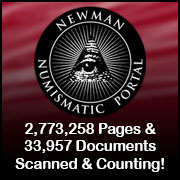
About UsThe Numismatic Bibliomania Society is a non-profit association devoted to the study and enjoyment of numismatic literature. For more information please see our web site at coinbooks.org SubscriptionsThose wishing to become new E-Sylum subscribers (or wishing to Unsubscribe) can go to the following web page link MembershipThere is a membership application available on the web site Membership Application To join, print the application and return it with your check to the address printed on the application. Print/Digital membership is $40 to addresses in the U.S., and $60 elsewhere. A digital-only membership is available for $25. For those without web access, write to: Charles Heck, Treasurer
AsylumFor Asylum mailing address changes and other membership questions, contact Chuck at this email address: treasurer@coinbooks.org SubmissionsTo submit items for publication in The E-Sylum, write to the Editor at this address: whomren@gmail.com BUY THE BOOK BEFORE THE COINSale Calendar
|
- WAYNE'S WORDS: THE E-SYLUM DECEMBER 22, 2019
- JOURNAL OF EARLY AMERICAN NUMISMATICS V2N2
- JOURNAL OF EAST ASIAN NUMISMATICS NO. 16
- BOOK REVIEW: THIAN'S MASTERPIECE
- MAURICE A. STORCK SR. (1922-2019)
- NEWMAN PORTAL ADDS THE NUMISMATIST THRU 2002
- VIDEO: 2019 WORLD'S FAIR OF MONEY HIGHLIGHTS
- FOUR EDUCATIONAL VIDEOS ON COLONIAL COINAGE
- MORE CHRISTMAS COIN BOXES
- NOTES FROM E-SYLUM READERS: DECEMBER 22, 2019
- VOCABULARY TERM: HANDCUT, HAND ENGRAVING
- ERNEST ROBINSON ACKERMAN (1863-1931)
- HARVEY STACK'S NUMISMATIC FAMILY, PART 59
- GREYSHEET PROFILES DELL LOY HANSEN
- FRANKLIN'S LIBERTAS AMERICANA MEDAL DISPLAY
- CLASSICAL NUMISMATIC GROUP TRITON XXIII SALE
- STEPHEN ALBUM RARE COINS AUCTION 36
- NUMISMATIC NUGGETS: DECEMBER 22, 2019
- WHAT IS ‘TREASURE'? ASK THE CORONER
- WAYNE'S NUMISMATIC DIARY: DECEMBER 22, 2019
- NEW ZEALAND STERLING COINAGE OFFERED
- CONGRESS WON'T SPEND MONEY ON MONEY
- LOOSE CHANGE: DECEMBER 22, 2019
- OXFORD NUMISMATIC SOCIETY CHRISTMAS 2019
Click here to access the complete archive
Click here to unsubscribe (scroll down)
To comment or submit articles, reply to whomren@gmail.com
Content presented in The E-Sylum is not necessarily researched or independently fact-checked, and views expressed do not necessarily represent those of the Numismatic Bibliomania Society.
WAYNE'S WORDS: THE E-SYLUM DECEMBER 22, 2019
 New subscribers this week include: Bill Burns, and Rodrigo Maldonado. Welcome aboard! We now have 6,072 subscribers.
New subscribers this week include: Bill Burns, and Rodrigo Maldonado. Welcome aboard! We now have 6,072 subscribers.
Thank you for reading The E-Sylum. If you enjoy it, please send me the email addresses of friends you think may enjoy it as well and I'll send them a subscription (but let me know if they are located in the European Union). Contact me at whomren@gmail.com anytime regarding your subscription, or questions, comments or suggestions about our content.
NBS Members: It's that time of year again - please renew your membership by check or online with Paypal. For more information, see:
https://www.coinbooks.org/about/
membership.html
This week we open with two new journal issues, an obituary, updates from the Newman Numismatic Portal and the Colonial Coin Collectors Club, and notes from E-Sylum readers.
Other topics this week include Christmas coin boxes, hand engraving, collectors Ernest Ackerman and Dell Loy Hansen, the Libertas Americana medal, auction previews from Stephen Album and Classical Numismatic Group, and New Zealand sterling coinage.
To learn more about the Fugio restrikes, Samuel Atlee's plea for compassion, the Peking Mint, Maurice A. Storck Sr., Vermont Coppers, the Arthur Stewart Collection, the EID MAR Denarius, Pidcock's Farthing Token, the Waitangi Crown, and the Holiday Theft at Nummis Nova, read on.
Happy Hanukkah, Merry Christmas, and have a great week, everyone!
Wayne Homren
Editor, The E-Sylum
JOURNAL OF EARLY AMERICAN NUMISMATICS V2N2
The latest issue of the Journal of Early American Numismatics (JEAN) has been published. Editor Chris McDowell shared this summary. Thanks. -Editor
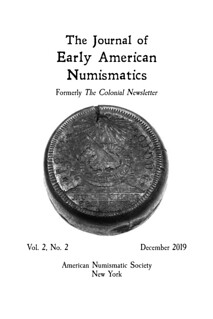 This week the ANS received the press proofs for the December 2019 issue of the Journal of Early American Numismatics (JEAN). The proofs have been approved and
JEAN 2:2 will be mailed to subscribers starting next week, and should be received by everyone by the end of the year or first week of January. This issue is again a book-sized
edition with over 200 pages of articles. The December issue is anchored by a large monograph on Fugio restrikes by Christopher McDowell and Julia Casey.
This week the ANS received the press proofs for the December 2019 issue of the Journal of Early American Numismatics (JEAN). The proofs have been approved and
JEAN 2:2 will be mailed to subscribers starting next week, and should be received by everyone by the end of the year or first week of January. This issue is again a book-sized
edition with over 200 pages of articles. The December issue is anchored by a large monograph on Fugio restrikes by Christopher McDowell and Julia Casey.
This Fugio article answers many of the mysteries of the Fugio restrikes. Based upon the evidence presented in the article, the Fugio "restrike" dies found by C. Wylys Betts and Horatio N. Rust in New Haven were engraved in 1788 for use as part of the original Fugio coinage contract and not, as generally believed, mid-19th-century fakes. Although the breadth and scope of the monograph is difficult to capture in truncated form, it is worth sharing one of the many new discoveries:
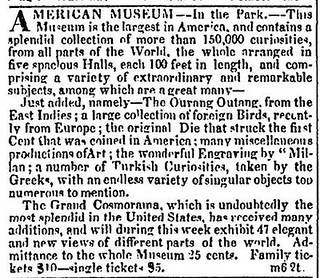
This is an advertisement from March 6, 1828, for the American Museum in New York, indicating that the museum had a Fugio die (the American Museum actually had a pair of Fugio dies—an obverse and a reverse, as detailed and proven in the article). Standing alone, this advertisement does not demonstrate that the dies found in New Haven in 1859 are authentic, but taken in conjunction with a host of other new discoveries, it is a piece of the puzzle.
One of the difficulties past researchers have encountered with the Fugio restrikes is that the number of dies in existence combined with the dies known to have been used to mint the coins exceeds the number that Rust and Betts claim were recovered in New Haven. Research presented in this article shows that possibly as many as 12 Fugio "restrike" die pairs survived into the 19th-century, and only roughly half of the then existing dies were found by Betts and Rust in New Haven.
The remaining 6 die pairs have been attributed to Charles Ira Bushnell, but research clears him of making these dies. The three extant Fugio restrike dies now in the ANS collection originate from the 1859 New Haven discovery. A fourth die, now located in a Connecticut museum, was also originally in the hardware store where Rust and Betts found the New Haven dies, but was removed prior to 1859. The obverse Fugio "restrike" die now in Yale University's collection was not part of the New Haven discovery, and the article argues that the Yale die was one of the dies exhibited at the American Museum in 1828.
The entire article must be read to understand the full story of the Fugio restrike dies, including when, where, and why these dies were made and how they survived the closure of the Connecticut mint in 1788.
The December issue of JEAN contains many other fabulous articles on a wide-range of colonial numismatic topics expressed in the Index. This issue is sure to be referenced by researchers and collectors for decades to come.
Christopher R. McDowell,
Editor, JEAN
Editor's Preface
The Authentic Fugio Restrike Dies: Newly Explained Through the Biographies of C. Wyllys Betts, Horatio N. Rust, Charles Ira Bushnell, and Others
Christopher R. McDowell and Julia Casey
The Duyckinck Family and Copper Coinage
Gary A. Trudgen
Samuel Atlee's Plea for Compassion
Gary A. Trudgen
The Eric P. Newman Papers on the Newman Numismatic Portal
Len Augsburger
Brief Analysis of Colonial Paper Money of Spanish New Orleans (1782–1796)
Ángel O. Navarro-Zayas
To subscribe, visit: http://numismatics.org/store/cnl/ or email Emma Pratte at epratte@numismatics.org .
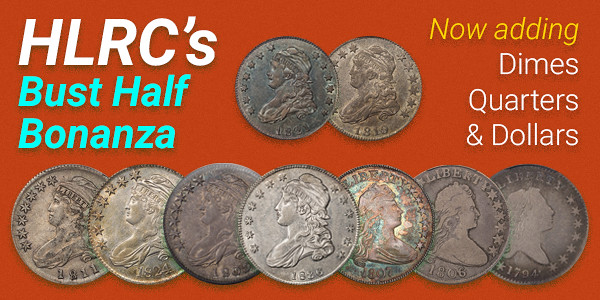
JOURNAL OF EAST ASIAN NUMISMATICS NO. 16
The other JEAN, the Journal of East Asian Numismatics, has just released its sixteenth issue. Thanks to David Sundman for passing word along. -Editor
FEATURES
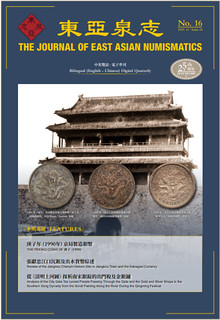 The Peking Coins of ?? (1900)
The Peking Coins of ?? (1900)
James O. Sweeney?USA?
Another View on The Peking Mint of 1900
Bruce W. Smith?USA?
Notes on the Peking Mint
RNJ Wright?UK?
Review of the Jiangkou Chenyin Historic Site in Jiangkou Town and the Salvaged Currency
Zhou Bian?Shanghai?
Analysis of the City Gate Tax Levied People Passing Through the Gate and the Gold and Silver Shops in the Southern Song Dynasty from the Scroll Painting Along the River
During the Qingming Festival
Che-lu Tseng?USA?
DEPARTMENTS
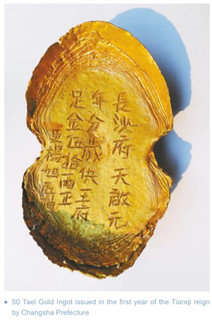 The Ancient Coin Book Series
The Ancient Coin Book Series
Zhou Bian ?Shanghai?
Jilin Copper Coins
Zhou Bian ?Shanghai?
Collection of Sichuan Malan Tokens
Zhou Bian ?Shanghai?
J.C. Lee Interview
Colin Gullberg?Taipei?
Update From the Summer 2019 ANA World's Fair of Money Show in Chicago
J. Matthew Brotherton?USA?
COLUMNS
Chopmarked Coins Chapter 3 - Understanding Chopmarks
Colin James Gullberg?Taipei?
Exploring Official Versions of Chinese Modern Precious Metal Coins
Zhao Yansheng?Beijing?
To read the complete issue online, see:
https://issuu.com/jeandigitala1/docs/the_sixteenth_issue_of_jean

BOOK REVIEW: THIAN'S MASTERPIECE
Joel Orosz submitted this mini-review of David Fanning's new book on the literature of Confederate paper money. See the previous article (linked below) for ordering information. -Editor
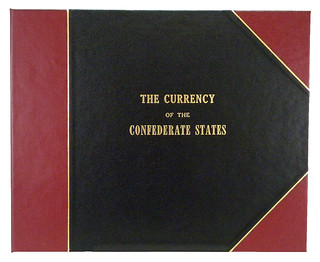 While this note will not rise to the level of a formal review of David F. Fanning's Thian's Masterpiece and the Early Literature of Confederate Paper
Money, perhaps it will serve as a recommendation to add this instant classic to your library.
While this note will not rise to the level of a formal review of David F. Fanning's Thian's Masterpiece and the Early Literature of Confederate Paper
Money, perhaps it will serve as a recommendation to add this instant classic to your library.
As the title implies, Thian's Masterpiece presents an excellent review of the literature on Confederate paper money published during the 19th century, starting with the man who got there, Nathan Bedford Forrest-like, "fustest" though certainly not with the "mostest," Thomas Addis Emmet, and culminating with Raphael P. Thian's early 20th century Currency of the Confederate States of America. That alone would be a worthwhile subject, and the fact that Fanning has printed only 100 copies assures their rarity.
A total of 24 of these 100, however, have been enhanced both externally (bound in a custom-made portfolio) and internally (including an original leaf, that is, both sides of a page, from an incomplete copy of Thian's The Currency of the Confederate States of America). The leaf is mounted in a transparent mylar sleeve bound into the portfolio, so that both sides are clearly visible.
Thian's currency books have been on the wish list of virtually every numismatic literature collector since they were created, but not many were made to start with, and since many of these were broken up over the years for the notes they contained, only a select few bibliophiles can ever own an intact copy. With Kolbe and Fanning's acquisition of an imperfect copy and the decision to make it into leaf books, at least a piece of a legendary rarity becomes a bit more accessible to collectors.
But only 24 copies with leaves were produced, and only 9 of those include notes, so the leaf books are a rarity unto themselves. Even the leafs without notes are highly desirable, however, so consider the opportunity of acquiring such an extraordinary piece of American--and bibliophilic--history for your library. But don't ponder too long--this opportunity, like the Ghost of Christmas present, will not be with us for long.
To read the earlier E-Sylum article, see:
NEW BOOK: THIAN'S MASTERPIECE: A LEAF BOOK (https://www.coinbooks.org/v22/esylum_v22n49a02.html)

MAURICE A. STORCK SR. (1922-2019)
Tony Tumonis of Glass Shoppe Coins in Tucson, Arizona writes:
I wanted to let you know that Maurice A. Storck Sr. passed away on November 29, 2019 at the age of 97 years. Maurice A. Storck was a Pearl Harbor survivor and coin dealer from Maine that attended the King Farouk Sale in Cairo Egypt in February 1954. Later Maurice moved to Tucson Arizona and we became friends. Throughout the years I purchased many coins and currency from Maurice. A few years ago Maurice sold me his extensive library. The attached photograph is of Maurice and myself at my store.
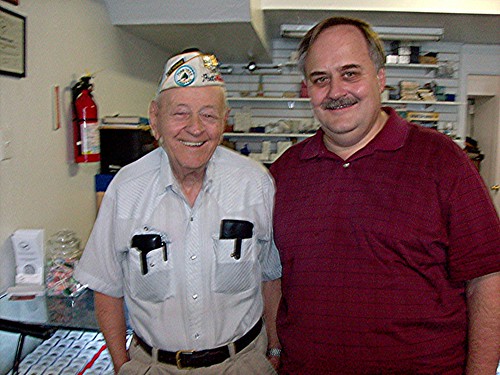
Maurice A. Storck Sr. and Tony Tumonis
Thanks. We missed the news when it first came out. See the earlier articles for more information. The Coin World piece has a great photo of Maurice atop a camel while in Egypt for the Farouk sale. -Editor
"Members of the Storck family indicate that Mr. Storck, at the time of his death, still had many of the bulk lots he had purchased at the Farouk sale still in his possession."
To read the Coin World article, see:
Last U.S. numismatist at 1954 Farouk auction dies at 97
(https://www.coinworld.com/news/us-coins/last-u-s-numismatist-at-1954-farouk-auction-dies-at-97)
To read the earlier E-Sylum articles, see:
COIN DEALER MAURICE A. STORCK (https://www.coinbooks.org/v20/esylum_v20n21a21.html)
HAPPY BIRTHDAY: MAURICE STORCK (https://www.coinbooks.org/v21/esylum_v21n22a24.html)

NEWMAN PORTAL ADDS THE NUMISMATIST THRU 2002
The latest addition to the Newman Numismatic Portal is a long run of The Numismatist. Project Coordinator Len Augsburger provided the following report. Thanks. -Editor
ANA Opens The Numismatist Through 2002 on Newman Portal
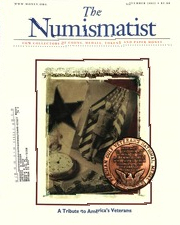 The standard bearer of American numismatics, The Numismatist has been published by the ANA since 1888. The Numismatist includes timely numismatic news,
feature articles appealing to a wide audience, and extensive coverage of ANA programs and conventions. Columnists such as Q. David Bowers and David Lange are ever-engaging, and
the monthly issue is a must-read for anyone involved in American numismatics.
The standard bearer of American numismatics, The Numismatist has been published by the ANA since 1888. The Numismatist includes timely numismatic news,
feature articles appealing to a wide audience, and extensive coverage of ANA programs and conventions. Columnists such as Q. David Bowers and David Lange are ever-engaging, and
the monthly issue is a must-read for anyone involved in American numismatics.
The ANA today announces that all issues through 2002 are now available for full-view via Newman Portal. Issues beginning in 2003, and coinciding with the launch of the full-color format, will remain search-only on Newman Portal. ANA members may continue to access all issues with full-view on the ANA website. Newman Portal acknowledges ANA and thanks ANA Executive Director Kim Kiick for her support with this content.
Link to The Numismatist on the ANA site:
https://www.money.org/thenumismatist/digitalarchives
Link to The Numismatist on Newman Portal:
https://nnp.wustl.edu/library/publisherdetail/510969

VIDEO: 2019 WORLD'S FAIR OF MONEY HIGHLIGHTS
These are selections from the David Lisot Video Library that feature news and personalities from the world of coin collecting. David has been attending coin conventions since
1972 and began videotaping in 1985. The Newman Numismatic Portal now lists all David's videos on their website at:
https://nnp.wustl.edu/library/multimediadetail/522852
Here's one featuring highlights of the ANA World's Fair of Money in Rosemont, IL earlier this year. -Editor
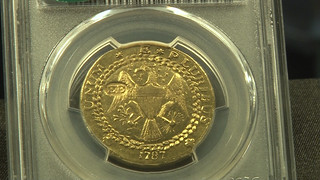 ANA Convention World's Fair of Money Highlights Rosemont, 2019
ANA Convention World's Fair of Money Highlights Rosemont, 2019
An excerpt of the video is available for viewing on the Coin Television YouTube Channel at:
https://youtu.be/rQESqNzpmww
The American Numismatic Association brings out some of the rarest of coins. Interviewer David Lisot talks to dealers who share almost ten million dollars of rarities including Frederick Bart, Executive Currency, $10,000 1934 Very Choice New 64, Mark Borckardt, Senior Numismatist, Heritage Auctions, 1787 Brasher Doubloon EB on wing PCGS MS63, John Brush, President, David Lawrence Rare Coin, D.L Hansen Collection 1884 Trade Dollar PCGS PF67 Finest Known, Dan Duncan, Co-Owner, Pinnacle Rarities, 1836 Bust Half Dollar PCGS PR64 CAC, Dennis Fortier, Member, Barber Coin Collectors' Society, barbercoins.org, Morgan Dollar "Blob" from San Francisco Earthquake Mint fire, Gilman Parsons, Parson Books, 1500's Bronze Mateo d'Pasti Maletesti, Kenneth Goldman, Kenneth Goldman, Inc., 1737 Higley Copper NGC VF, Kent Ponterio, Partner, World Numismatics, France 1607A Silver Franc Quadruple Piefort Henry IV PCGS XF45, Spain Gold 4 Escudo Ferdinand V & Isabel I NGC AU53, Roman Gold Aureus Sept. Severus AD 193-211 Julia Domna reverse NGC Ch Mint State, David Stagg, Owner, David C. Stagg, Inc., 1922 "No D" Lincoln Cent PCGS F12 Strong Reverse.
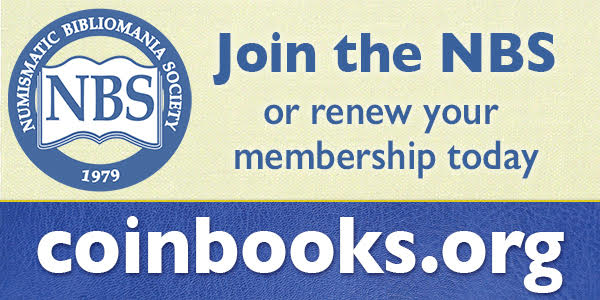
FOUR EDUCATIONAL VIDEOS ON COLONIAL COINAGE
The Colonial Coin Collectors Club (C4) has rolled out four new educational videos. Here's the announcement. -Editor
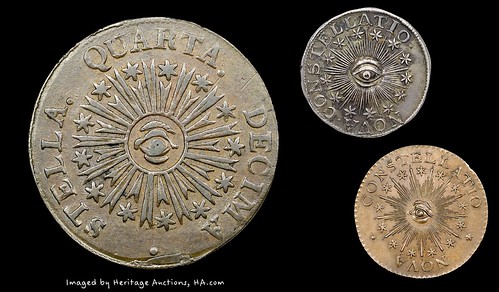
From the Vermont Coppers video
The Colonial Coin Collectors Club (C4) has produced four educational videos on Colonial coinage. Specifically, videos on Fugio coppers, Connecticut coppers, Vermont coppers, and New Jersey coppers. All four videos were placed on the C4 website this week and can be found at: http://colonialcoins.org/c4media/
These videos were prepared in conjunction with Lianna Spurrier, our producer, and are designed to present a short introduction to each series. The videos depict a brief history of the coins along with information on how they are collected today. In preparing the videos, C4 drew upon the expertise of several individuals including Q. David Bowers (Vermonts), Roger Siboni and Ray Williams (New Jersey coppers), and Christopher McDowell (Connecticut and Fugio coppers).
C4 is currently working on an additional video on Massachusetts coppers that should be finalized in another month. The officers and directors of C4 are very pleased with these educational videos and hope that through the use of this media we can reach a wider audience. The videos help fulfill C4's charter mission of educating the public about colonial numismatics.
After one year, C4 intends to license the videos to the Newman Portal so they can reach even more people.
Lianna does great work. All are well worth watching; even longtime collectors will find something to learn. Congratulations to C4 on this excellent program. -Editor
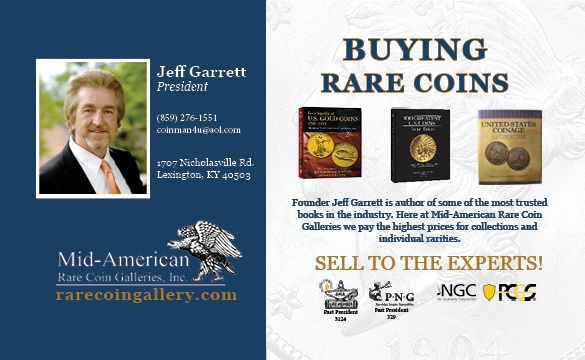
MORE CHRISTMAS COIN BOXES
Michael Wehner writes:
I recalled after reading the last E-Sylum that I have a pair of the gold coin Christmas boxes. One is just as you showed. But the other is more patriotic. Alas, they are both empty. See attached for the eagle one, I think for a $5 gold piece.
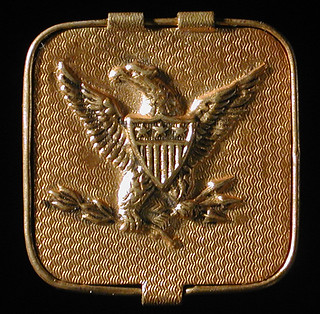
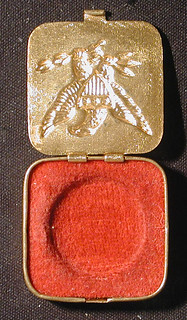
Very nice! -Editor
ANA Edition reader Jeremy Schneider writes:
I enjoyed the article on Christmas coins; it is unfortunate that this tradition has fallen out of favor. Several years ago, I purchased this 1882 half eagle and have always wondered the intention of the little box that it came in- after reading Len's article I'm thinking that perhaps this was somebody's Christmas present at one time.
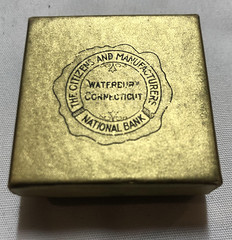
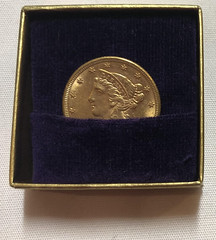
Thanks, everyone! -Editor
To read the earlier E-Sylum article, see:
CHRISTMAS COINS ON THE NEWMAN PORTAL (https://www.coinbooks.org/v22/esylum_v22n49a08.html)
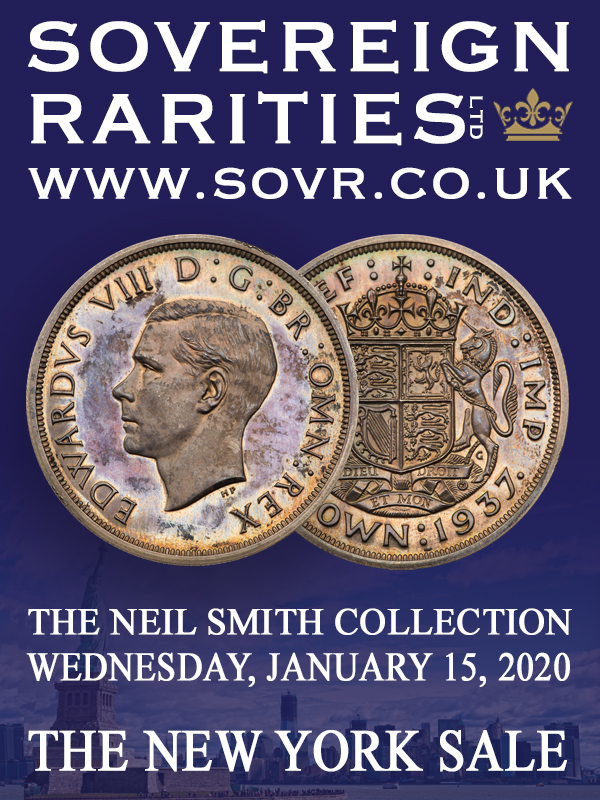
NOTES FROM E-SYLUM READERS: DECEMBER 22, 2019
Spink's Lightning Shipping
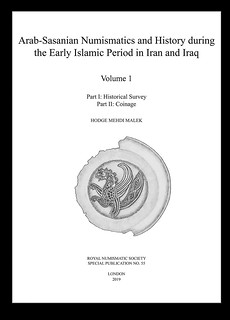 Fred Liberatore of Massachusetts writes:
Fred Liberatore of Massachusetts writes:
My younger brother ordered the new book on Islamic coins from Spink's as well as two others and they arrived TWO days later!!!!! He is thrilled with them. Without The E-Sylum, he likely would have missed them. I will likely order them also.
Glad to help! Happy reading and collecting! -Editor
To read the earlier E-Sylum article, see:
NEW BOOK: ARAB-SASANIAN NUMISMATICS AND HISTORY (https://www.coinbooks.org/v22/esylum_v22n50a02.html)
Money Laundering, Literally
Bob Leuver is a former Director of the Bureau of Engraving and Printing and later served as Executive Director of the American Numismatic Association. The article on unaccounted-for currency reminded him of this episode from earlier in his career. Thanks. -Editor
Bob writes:
I recounted this story to James Baker, new Secretary of Treasury, shortly after his appointment (1985), when he visited the Bureau of Engraving and Printing—possibly when he provided his signature for US currency. The story was meant to show the Secretary different ways currency was used. Sec. Baker, an obvious student, asked a series of questions afterwards to learn more about currency.
A number of years prior to my government service, I was arranging a loan to build a printing factory in a South American country. Casting about for a loan, I flew to a Pacific coast So. American country to possibly secure either the loan or part thereof. In the capital of the country I met with a bank official. After the meeting, he suggested lunch. Over lunch he launched into a discussion of how the bank stored and used US currency. He used the word "lavar," as "We wash US currency." Being part Italian and from Chicago I interpreted the word and phrase as "We launder US currency."
After my astonishment, he explained in Spanish what he meant. He then took me back to a sub-basement of the bank. There were five washing machines. He explained the bank washed US currency to remove the "mugre," the dirt, oil and grit. There were stacks of US currency, mostly high denomination. He explained, "US currency is more stable, easier to obtain and better negotiable than gold."
Now, with a better numismatic knowledge, I wonder if some precious notes might reside in bank vaults around the world.
Bob also passed along this follow-up comment from Leonard Olijar, current Director of the BEP:
Thanks Bob. I'm sure you are aware that Treasury did the same thing - just more than a century ago.
The world loves the US dollar. No one knows how many $100s are being held abroad, but the are more $100 notes in circulation today (over 12 billion) that there are $1 notes. As we have redesigned the $100 a few times, we have noticed that older design $100s are worth less in many countries than new design $100s. In some countries, they won't even accept old design notes.
To read the earlier E-Sylum article, see:
HOW MUCH CASH IS IN HIDING? (https://www.coinbooks.org/v22/esylum_v22n50a22.html)
Couple Convicted of Laundering Postage Stamps
On a somewhat related note, the Daily Mail published an article this week about a couple who made a handy business out of cleaning and reselling postage stamps. -Editor
 A married couple whose lavish lifestyle was funded by washing 700,00 used stamps and selling them as new on eBay and Amazon have been convicted of fraud.
A married couple whose lavish lifestyle was funded by washing 700,00 used stamps and selling them as new on eBay and Amazon have been convicted of fraud.
Paul Harrison, 52, defrauded Royal Mail out of more than £400,000 by removing the stamps' frank marks so they could be passed off as new to people online.
He and his wife Samantha, 44, used the proceeds of the elaborate fraud to pay for luxury holidays and a BMW with personalised number plates.
"But Your Honor, we're recycling! That's a GOOD thing, right? We're doing it for the PLANET!" -Editor
To read the complete article, see:
Married couple funded lavish lifestyle by washing
700,000 used stamps then selling them as if new on Amazon and eBay in elaborate £225,000 fraud
(https://www.dailymail.co.uk/news/article-7806207/Couple-washed-700-000-used-stamps-sold-Amazon-eBay-225-000-fraud.html)
Steel Cent Webbing Packaging
Tony Tumonis writes:
Attached is a photo of one of the steel cent webbing pieces offered in The Numismatist for $5.00 postpaid with the original mailing envelope. If you notice the 3 cent postage then from Oakland CA. to Omaha NE.
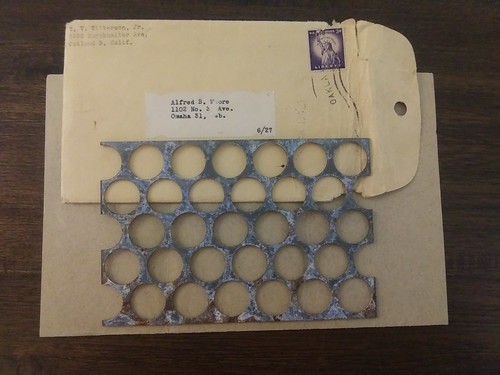
Cool item. Thanks! -Editor
To read the earlier E-Sylum article, see:
NOTES FROM E-SYLUM READERS: DECEMBER 8, 2019 : More on the Steel Cent Webbing
(https://www.coinbooks.org/v22/esylum_v22n49a10.html)
Correction: Fillet
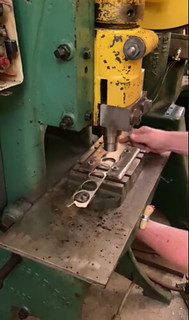 Last week Len Augsburger wrote "With respect to skeleton scrap, Phil Mossman has used the word "fillet," ..." Phil writes:
Last week Len Augsburger wrote "With respect to skeleton scrap, Phil Mossman has used the word "fillet," ..." Phil writes:
However, this is not how I used fillet. The quote as it appears on p. 223 in Money is: "the reworked scissel, i.e. the remains of the copper fillet after the planchets had been cut or stamped from it."
Len writes:
Phil is 100% right, as usual. I was going too fast.
Thanks, everyone. -Editor
To read the earlier E-Sylum article, see:
WEBBING DEFINITIONS ON THE NEWMAN PORTAL (https://www.coinbooks.org/v22/esylum_v22n50a05.html)
John Leonard Riddell's Sign of the 8
Steve Feller writes:
There is a well-known Confederate stamp made to the order of Postmaster John Leonard Riddell. It has an extraneous 8 on it. I've not seen a good reason why. Perhaps it's related to the sign of the eight. I show below the two cent New Orleans Provisional stamp of 1861--no 8 and the five cent New Orleans Provisional stamp of 1861 with the enigmatic 8 in the five! The New Orleans above the stamp is an imprint on the sheet itself.
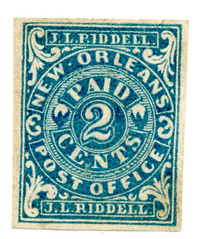
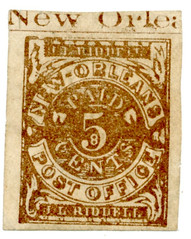
That eight looks just a little fatter on top than the bottom - is it an upsidedown eight? Strange. -Editor
To read the earlier E-Sylum article, see:
MORE ON THE "SIGN OF THE 8" (https://www.coinbooks.org/v22/esylum_v22n50a08.html)
John Hull's Grave
Steve Feller writes:
 John Hull, the mintmaster, is buried in a grave of several people in Boston's Granary Burying Ground located on Tremont Street. Also, the following famous
individuals are there: Peter Faneuil, Sam Adams, Crispus Attucks, John Hancock and Paul Revere among many well-known people. It takes some effort to find John Hull there but he is
there!
John Hull, the mintmaster, is buried in a grave of several people in Boston's Granary Burying Ground located on Tremont Street. Also, the following famous
individuals are there: Peter Faneuil, Sam Adams, Crispus Attucks, John Hancock and Paul Revere among many well-known people. It takes some effort to find John Hull there but he is
there!
Thanks - I didn't know that. Earlier this year we discussed destinations for a numismatic walking tour of New York City. What would be the best stops for a Boston tour? -Editor
To read the earlier E-Sylum articles, see:
JIM NEISWINTER'S NEW YORK NUMISMATIC TOUR (https://www.coinbooks.org/v22/esylum_v22n29a14.html)
NATHANIEL HAWTHORNE: GRANDFATHER'S CHAIR (https://www.coinbooks.org/v22/esylum_v22n50a12.html)
That Pesky Internet Keeps Changing on You
Regarding that odd "PREFACE" typo, Ron Haller-Williams writes:
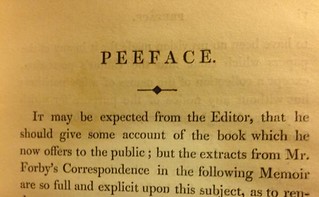 For some reason I looked again at this, and found that the source I referenced now has the CORRECT spelling !!!!
For some reason I looked again at this, and found that the source I referenced now has the CORRECT spelling !!!!
I wouldn't have thought it worth jogging people's memory, but it goes to show that ... things change!
A Google search will offer over 37000 hits, nearly all in "books"; but I believe that over 97% of these are instances of the OCR (optical character recognition) being fooled. So you can't take anything for granted! "It ain't necessarily so" that the source actually says what it is said to say.
To read the corrected version, see:
https://www.forgottenbooks.com/en/readbook/TheVocabularyofEastAnglia_10073104#4
To read the earlier E-Sylum article, see:
WAS THIS TYPO PHOTOSHOPPED? (https://www.coinbooks.org/esylum_v18n19a20.html)
Query: New York Custom House Cornerstone
Dave Bowers writes:
In 1902 the cornerstone for the new Custom House in New York City was laid. Included in it was a complete set of 1902 coinage in all metals. Wonder if it is still there?
Great question. Is there any record of the time capsule being opened? -Editor
Banknote World Educational Site
Regarding our recent discussions on world banknote catalog sites, there is also Banknote World's educational site. The commercial counterpart was mentioned in 2015 by Jeff Starck. -Editor
This site is dedicated to everything banknote related and to its community of collectors. We offer images and information on tens of thousands of past and present notes. Find specific banknote issues using the search fields, or explore notes from all over the globe by clicking the geographic links under the Home tab.
Since there are millions of banknotes throughout the world we can assure you that we definitely do not have all the banknotes. If you don't find what you're looking for here, please help us by adding any missing banknotes. Contributions from visitors like you help make Banknote World an indispensable resource for collectors and hobbyists from all over the world.
To visit the site, see:
https://www.banknoteworld.org/
To read the earlier E-Sylum articles, see:
MORE ON BANKNOTE CATALOG WEB SITES (https://www.coinbooks.org/v22/esylum_v22n50a09.html)
FEATURED WEB SITE: BANKNOTE WORLD (https://www.coinbooks.org/esylum_v18n29a42.html)
THE BOOK BAZARRE
VOCABULARY TERM: HANDCUT, HAND ENGRAVING
Dick Johnson submitted this entry from his Encyclopedia of Coin and Medal Terminology. Thanks. -Editor
Handcut, Hand Engraving. Freehand cutting a metal surface or dies of any kind in the size required, by a human engraver. Hand engraving is in contrast to machine engraving, first developed in the 18th century and widely employed after 1900. Even with the development of diecutting machines, portrait lathes and various engraving machines, the need still continues for hand engraving and handcut dies. Cost and speed are two strong factors in favor of hand engraver, another is the ability to produce a die from a drawing without being required to have a three-dimensional pattern or model. Handcutting dies is the time honored way of diesinking – all dies were handcut in whole or in part prior to 1850 – the number steadily diminishing until only a small portion are handcut in the 20th century. See also ENGRAVING, How to tell Hand Engraving from Machine Engraving.
Handcut versus machine engraving. In some ways it is impossible to tell for certain if a struck piece was from dies that were hand engraved or if some form of machine engraving was used in their preparation. Some general guidelines may be offered but these may not be exclusive to either type of engraving. Thus the following can serve as guidelines only:
Handcut dies and pieces struck from such dies tend to have sharper lettering and detail. The devices appear well defined, the relief and lettering may have somewhat steeper sides (with steeper draft or bevel). The lettering is often produced by punches, thus similar letters may be from the same punch and be identical. The top of the lettering (from the end of the punch) may be flatter; there are sharper angles at the top and base of lettering and relief. There is a sharp juncture of the device and the background. Overall the appearance of handcut pieces is sharper, well defined images and lettering.
Pieces struck from modeled and machine cut dies are generally softer in appearance; there are no sharp angles present at either the top or at the base of lettering or detail, thus effecting the softer appearance. The lettering appears more rounded. The device appears to blend into the background or field, as there is no sharp juncture at the base. There is more modulated relief in the device, and indeed, the entire struck surface is formed from one continuous modeled plane of the three-dimensional plaster model. Portraits tend to appear more lifelike.
There are some technical reasons for the differences between the types of engraving. The most important of these is the shape of both the tracing point and the cutting point on the diecutting machine. If the tracing point cannot enter the crevice in the model it will not reproduce this in the die; also the bevel is limited to 15%, it cannot reproduce less than this angle of slope in the die, while a handcut die can accommodate as little as 5% bevel.
The two great limitations of handcutting a die are, of course, that it has to be cut the exact size and that it is difficult to correct a cut once it has been made. This corresponds to the great advantage of the oversize model for machine diecutting which can be carved and changed repeatedly before the final stage, a model can be reduced to any size die required, and any number of dies can be made from one bas-relief model (dieshell).
See engraving.
Looking for the meaning of a numismatic word, or the description of a term? Try the Newman Numismatic Portal's Numismatic Dictionary at: https://nnp.wustl.edu/library/dictionary
Or if you would like a printed copy of the complete Encyclopedia, it is available. There are 1,854 terms, on 678 pages, in The Encyclopedia of Coin and Medal Technology. Even running two a week would require more than 19 years to publish them all. If you would like an advance draft of this vital reference work it may be obtained from the author for your check of $50 sent postpaid. Dick Johnson, 139 Thompson Drive, Torrington, CT 06790.

ERNEST ROBINSON ACKERMAN (1863-1931)
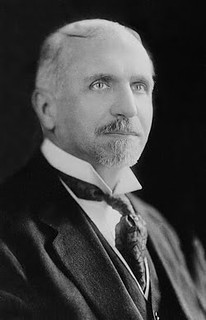 He was born in New York on June 17, 1863, son of James Hervey Ackerman and Ellen Morgan.
He was born in New York on June 17, 1863, son of James Hervey Ackerman and Ellen Morgan.
According to the 1880 Census he was living with his father in Plainfield, New Jersey. He graduated Plainfield High School in 1880. From 1891 to 1892 he served as a councilman in Plainfield. In 1904 he worked for The Lawrence Cement Company – sales office located at No. 1 Broadway, Manhattan and mailed a business envelope to the Chapman Brothers purchasing two coin auction copies of the Mills catalog for $5.58 in cash, one plain and one plated.
On October 17, 1900 he wrote to the Chapman Brothers requesting a copy of the Dr. Edward Maris catalogue while he lived at 506 West 8th Street, Plainfield, New Jersey.
From 1905 to 1911 he served as a state senator. In 1907 he bought more coins from Henry Chapman, Jr.
He was a Fellow of the ANS in 1908. Also, in 1908 he was a Republican delegate to the National Convention in Chicago. In 1915 his home was robbed. From 1916 to 1920 he was a member of the Board of Trustees at Rutgers University (then College). From 1919 to 1931 he served as the Republican Party representative in New Jersey's 5th congressional district in the United States House of Representatives.
In 1923 he sponsored a bill to permit illustration of postage stamps in a limited way. He died October 18, 1931. His coin collection was sold at auction by Charles H. Fisher on June 27, 1931. A part of his valuable United States stamp collection was bequeathed to the Smithsonian Institution's National Postal Museum in Washington, D.C.
Ackerman was named to the American Philatelic Society Hall of Fame in 2000.
To read the complete article, see:
ACKERMAN, ERNEST ROBINSON
(https://sites.google.com/a/numismaticmall.com/www/numismaticmall-com/ackerman-ernest-robinson)
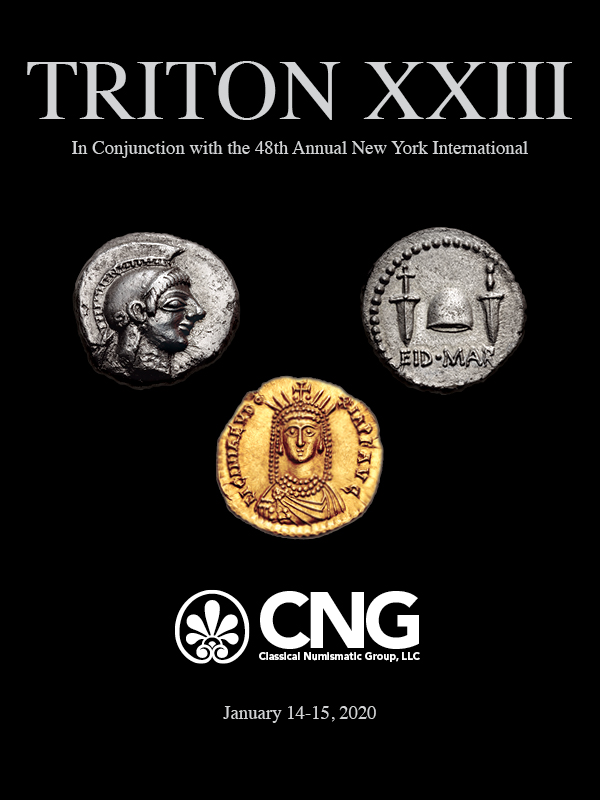
HARVEY STACK'S NUMISMATIC FAMILY, PART 59
The latest article in Harvey Stack's blog series is about four major collections sold in 1972. -Editor
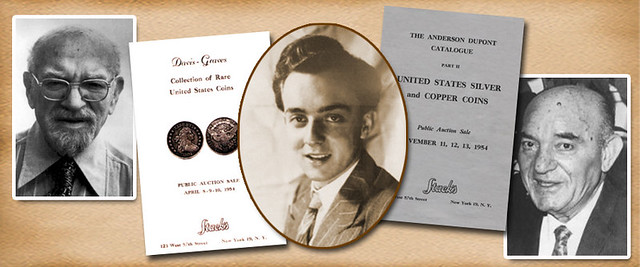
?In 1972, Stack's received consignments from major collections. This aided us in one of our other important roles, that of helping clients to start collecting and add to their already existing collections. As older collections came on the market, they provided the supply of pieces for newer numismatists to acquire and build the next generation of collections. In this year we were pleased to offer four general collections of United States gold, silver and copper coins along with four more major collections.
The four general collections were offered in February (1,274 lots), March (The Angelo Turrini Collection 1,293 lots), June (The Estate of Russell Hein, 1,161 lots) and December (The Lloyd Meyers Collection, (878 lots).
The first major collection sold in 1972 was The Arthur Stewart Collection. Arthur Stewart, former ANA Member #184, had assembled a wonderful type and date collection of United States coins that we offered in 1,808 lots in May. In September we held the superb S.S. Forrest Collection of U.S. coin, from rare types to early Proofs (1164 lots). The Alfred Globus Collection of superb gold coins of the world, 1600 to 1930, plus quality U.S. gold, comprised 1,052 lots sold in October. Dr. Globus always told the story that in the late 1940s his hobby, coin collecting, saved his business, as he was able to get a loan that saved his chemical business, by pledging his coins based on an appraisal of their value.
After we sold the Globus Collection, in November we had the Winner Delp Collection of rare United States coins. Winner Delp was an electrical engineer who developed parts for computers. He had started with Stack's collecting U.S. type coins, and had superb 1796 and 1827 quarters, a 1797 half dollar, 1858 dollar and 1884 trade dollar – highlights of his silver rarities. He also had a wonderful group of early gold types. All in all it was a prize collection with some 973 outstanding lots.
All in all, Stack's was pleased to offer these old time collections, some which we had also been instrumental in building, and some which we had been involved with in the early days they were assembled. 1972 was a monumental year with these fine and important collections,
In my next part of my Growing Up in Numismatics story, I will discuss how 1973 was a year of historic events and wonderful experiences as we worked to make numismatics grow and to attract more collectors.
To read the complete article, see:
Harvey Stack Remembers: Growing up in a Numismatic Family, Part 59
(https://www.stacksbowers.com/News/Pages/Blogs.aspx?ArticleID=Harvey-Stack-Remembers-Part-59)
To read the earlier E-Sylum article, see:
HARVEY STACK'S NUMISMATIC FAMILY, PART 58 (https://www.coinbooks.org/v22/esylum_v22n49a15.html)

GREYSHEET PROFILES DELL LOY HANSEN
An article on collector Dell Loy Hansen and his affect on the rare coin market appeared in print in the November 2019 issue of The Monthly Greysheet. Here's an excerpt - see the complete article online, -Editor
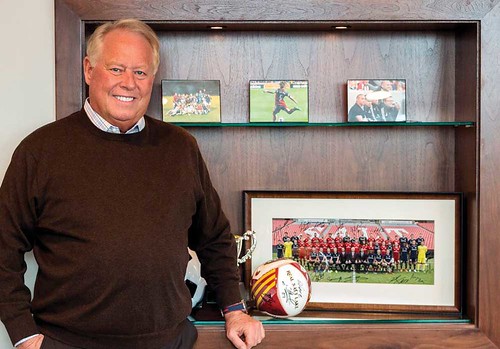
Numismatist Dell Loy Hansen is on a pursuit to build what he calls "The Greatest All-Time Collection of U.S. Coins," and he's making headlines while doing it. In just the past 18 months, the real estate developer has picked up three coins most numismatists dream for a lifetime about owning, including the 1894-S Barber dime, 1804 Draped Bust dollar, and 1885 Trade dollar—all multi-million-dollar coins, each with a colorful story capable of filling volumes.
But Hansen's goals were not once so lofty as besting what 20th-century Baltimore financier Louis Eliasberg did in 1950, when he completed what was then the most comprehensive United States coin collection ever. Back in 2016, Hansen had the simple goal of "building a nice set of Saint-Gaudens double eagles." But he quickly achieved that goal and wanted more. He set his sights on Eliasberg, a man whose collection was once prominently featured in Life magazine and, during the Bicentennial in 1976, drew one million visitors when it was displayed at the United States Mint in Philadelphia.
While it's natural for the numismatic world to sing the praises of what Hansen is doing, many inside the industry have a variety of opinions on what affect his Eliasberg moonshot has on the marketplace. One concern often heard relates to the general effect of a single buyer dropping many millions of dollars on rare coins in a short time, and its affect on the value of coins. In some cases, the market can be skewed by Hansen's, "I''ll pay whatever it takes" attitude when buying a prized item. The sellers of such items certainly aren't complaining, but the rest of the market can feel frozen out. According to CDN Publisher, John Feigenbaum, "the ramifications are complicated. At CDN we are working hard to predict accurate values for future coin trades, and Dell Loy's strategy can be a wild card. However, " Feigenbaum continues, "from my perspective the uncertainly and chaos adds a lot of excitement to the hobby and makes our job all the more interesting. We love seeing it, and I could only wish for more well-heeled collectors to enter the market."
DOUG WINTER
Douglas Winter Numismatics
Q. When you look at the discussion boards, there are a few critics who claim Hansen could've done better with this buy or that, or perhaps that he missed some rare opportunities to buy a couple pieces when he "had the chance." Do you agree?
The thing I find most amazing about what he's doing involves the compendium of knowledge that's required. He's doing Saints and early gold in Gem and Roosevelt dimes with Full Torches simultaneously—the amount of knowledge that's required to collect coins of the highest magnitude in so many different areas is pretty amazing. He's been criticized in certain areas for not doing one thing or doing another thing. I'd answer the critics that the breadth and scope of what he's doing is so difficult. He may not purchase the right coin the first time, but as he becomes more knowledgeable and sophisticated, he's buying some great pieces..
LAURA SPERBER
Legend Numismatics
Q. I understand you're not too keen on calling Hansen "the greatest collector ever." Is that an opinion you hold merely in collegial jest?
I have always agreed Mr. Hansen is ONE OF THE greatest collectors. Many people just do not know who else and what else exists like I do. There is a lot more to it than just spending the money to build a set. Even though he is buying much better now, he is still way off line on what he should be buying to earn the title of greatest collector. I'll still challenge him vs Bob Simpson or [the] Tyrant [Collection] any day for the title. I see things differently than how Mr. Hansen is buying—but, he can buy what HE wants, not what the people want. It's his collection, whether right or wrong, whatever makes him happy. I also think his learning curve has dramatically changed since he met JB [John Brush]. I can see he simply is choosing to complete his set, then upgrade.
Q. What are some of the short-term and long-term impacts of Hansen's collection and his objective to build such a large and comprehensive cabinet?
It's an amazing conquest he is working on. I think it has stimulated the collecting public's imaginations and maybe inspired some people. Many collectors like to know there is someone else out there who is as crazy as they are. The negative impact, he is taking many coins off the market for the long term which does not allow for others to build similar collections.
Q. You talk about coins coming off the market… Are there any especially rare coins he bought that represent especially good buys for him?
My personal 3-cent silver proof collection. It has the unique 1851 proof in GEM. His $20.00 Liberty set. Nothing comes close, nor will ever.
JOHN ALBANESE
CAC
Q. Hansen's bagged some big coins already, but he's got a few biggies to go, including the (sole legally obtainable) 1933 Saint-Gaudens $20. Do you see opportunities for Dell to pick up those last major rarities, and which coin might be the last?
I think if he wanted to pay the asking price… I believe he could pick up an 1854-S $5 for that matter. It could be a phone call away, it's not impossible. But, I think the last coin he will end up buying is the 1870-S half dime—that's in a collection with a well-known collector, and I don't think he's going to let it go. If the funds are unlimited, I think that will be the last coin he'll pick up.
To read the complete article, see:
Dell Loy Hansen has his eye on the Ultimate Prize: The
Greatest Collection of All Time (http://blog.greysheet.com/dell-loy-hansen-has-his-eye-on-the-ultimate-prize-the-greatest-collection-of-all-time/)
FRANKLIN'S LIBERTAS AMERICANA MEDAL DISPLAY
The Cardinal Collection Educational Foundation and Stack's Bowers are presenting a display on the Libertas Americana medals at next month's F.U.N. show. Here's the press release. A great opportunity for showgoers to see some amazing material, -Editor
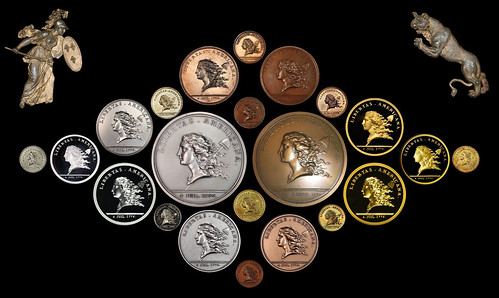
The Cardinal Collection Educational Foundation
Tribute to Benjamin Franklin's Libertas Americana Medal
Stack's Bowers Galleries is pleased to announce that it will display an incredible tribute to the Libertas Americana medal, assembled by the Cardinal Collection Education Foundation, at the upcoming Florida United Numismatists Convention in Orlando, January 9-11, 2020. The display, centered around one of the most beautiful and important medals struck in American history, will be found at the firm's bourse tables 420-422. Back by popular demand, this collection drew dozens of interested collectors at the ANA convention in August and will be enjoyed once more by those attending this year's FUN show.
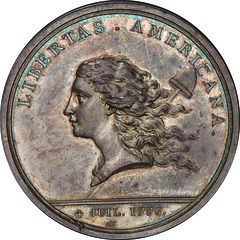
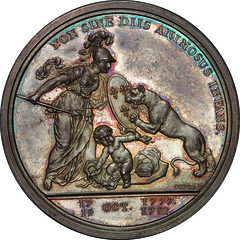
Following decisive victories at Saratoga and Yorktown, Benjamin Franklin wrote to the United States Secretary of Foreign Affairs Robert Livingston: "This puts me in mind of a medal I have had a mind to strike ... representing the United States by the figure of an infant Hercules in his cradle, strangling the two serpents; and France by that of Minerva, sitting by as his nurse, with her spear and helmet, and her robe specked by a few 'fleurs-de-lis.'" From concept to realization, execution, delivery, payment, and worldwide press coverage, Benjamin Franklin truly was THE man behind the historic Libertas Americana medals. He leveraged his position in France as the Minister Plenipotentiary representing the United States to garner support and connect with preeminent artists and engravers of the day. He personally stewarded the process to bring the Medals into reality. The manifestation of Benjamin Franklin's vision of Liberty -- the beautiful Libertas Americana Medal made in 1783 – struck a chord with the people and nations of the world, and ultimately became the inspiration for the Flowing Hair Liberty coinage of the First United States Mint.
From the very beginning, the Flowing Hair portrait of Lady Liberty was described as a "fine woman" and a "beautiful maiden." The lovely image of Lady Liberty inspired artists and engravers of the day, and became the genesis of the Flowing Hair and Liberty Cap coinage of the First United States Mint. Yet, the inspiration provided by Liberty did not end there, but has continued on through generation after generation, enduring in the minds of the public and spawning official restrikes and tribute pieces through to the present day. Not surprisingly, it was the unanimous choice for the Number 1 spot among the 100 Greatest American Medals and Tokens. While the original medals of 1783 may be challenging to acquire (especially those struck in silver), a series of later restrikes have been issued officially in a variety of metals and formats, allowing this beautiful and historic design to be within the reach of collectors everywhere.
The Cardinal Collection Educational Foundation's Tribute to the Libertas Americana medals includes examples of the original silver and bronze medals distributed by Benjamin Franklin himself, and examples of each of the denominations of the Flowing Hair/Liberty Cap coinage the medal inspired, spanning from the 1792 Copper Disme to the 1795 silver issues and ending with the half cent of 1797. Also included are Paris Mint official emissions of so-called "restrikes" (struck from newly engraved dies copied directly from the original dies), as well as period ephemera such as Benjamin Franklin's "Explication" of the Libertas Americana medal" (perhaps the only copy in private hands), a rare original plate from the 1784 book Historisch-Genealogischer Calender oder Jahrbuch der merkwurdigsten neuen Welt Begebenheiten fur 1784, by C. M.Sprengel, and an original etching of George Washington on horseback with an etching of the Libertas Americana medal beneath.
We invite those planning to attend this year's FUN convention to take the time to admire and study this remarkable display. For more information please contact Christine Karstedt by email at ckarstedt@stacksbowers.com.

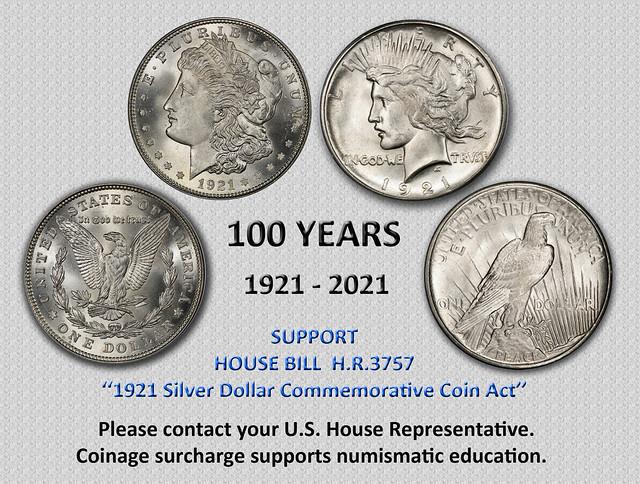
CLASSICAL NUMISMATIC GROUP TRITON XXIII SALE
Here is the press release for Classical Numismatic Group's January NYINC sale, Triton XXIII. Some amazing coins here. -Editor
Features Multiple Collections & Individual Rarities
Classical Numismatic Group, LLC of Lancaster, Pennsylvania and London, England is proud to present Triton XXIII, a Public, Internet, and Mail Bid Sale to be held in conjunction with the 48th Annual New York International Numismatic Convention (NYINC) on January 14-15, 2020. The 2020 NYINC will be held at the Grand Hyatt Hotel, located at 109 East 42nd Street, New York, NY 10022, between Park and Lexington Avenues. Triton XXIII features 1453 lots of Greek, Celtic, Oriental Greek, Central Asian, Roman Republican & Imperatorial, and Roman Imperial coinage. Additionally, there are featured selections of Byzantine, Islamic, Indian and Related Coinage, Early Medieval, World, and British coinage and medals, as well as a nice selection of large lots. The pre-sale estimate total for Triton XXII is just over $7.5 million.
Triton XXIII is highlighted by a number of collections and individual rarities, which make up the majority of coins on offer:
- Selections from the Jack A. Fraser Collection of Ancient, World, and British Coinage
- Further Selections of Ancient Coins from the Matthew J. Curtis Collection
- Greek and Roman Coins from the Jonathan P. Rosen Collection
- An Eid Mar Denarius
- Roman Imperial Gold from the Provence Collection
- Unique Aurelian & Vabalathus Gold Aureus
- Exceptional Licinia Eudoxia Solidus
- The Richard A. Jourdan Collection of Medieval European Coinage, Part I
- Charlemagne Portrait in Gold
- The Dr. William J. Conte Collection of Bracteates
- Coins of Richard III from the Arthur M. Fitts III Collection
- Anglo-Saxon & Tudor Gold Coins from the G.W. Trow Collection
- British Gold from the G.W.K. Roberts Collection, including a William IV Pattern Five Pounds from the Murdoch and Copp Collection
- Selections from the James & Martha Robertson Collection of British & Scottish Coinage
Lot viewing for Triton XXIII will begin on Sunday, January 12th, from 1PM until 7PM in the Broadway Room, located on the Conference Level (CC floor) of the Grand Hyatt Hotel. The complete lot-viewing schedule for Triton XXIII is:
Sunday, January 12, 2020 – 1PM until 7PM;
Monday, January 13, 2020 – 9AM until 7PM;
Tuesday, January 14, 2020 – 8AM until 6PM; and
Wednesday, January 15, 2020 – 8AM until Noon.
Auction lots will also be available for viewing at the Pennsylvania offices of CNG from Monday, December 2nd, 2019 until Friday, December 27th, 2019 by appointment only. Please note that CNG's office hours will be limited during the holiday season.
The auction sessions for Triton XXIII will be held in the Empire State Ballroom I, located on the Ballroom Level (B floor) of the Grand Hyatt Hotel. Triton XXIII will be conducted over four sessions with the morning sessions beginning promptly at 9:00 AM on Tuesday, January 14th, and Wednesday, January 15th, 2020, and the afternoon sessions will start at 2 PM on the same days.
In addition, there will be an online, Internet-only, Session 5 for Triton XXIII, which CNG will be conducting as our Electronic Auction 460, and will open for bidding on January 8th, 2020. E-Sale 460 will feature over 1,000 lots, with a closing date of Wednesday, January 29th, 2020, and will include coins from some of the same collections listed above.
Printed catalogs for Triton XXIII are now available. To order a catalog, please visit www.cngcoins.com. The catalog is $75 to North American addresses, and $100 to the rest of the world. Payment may be made by U.S. $ check or Visa/MasterCard. Catalogues have already been mailed to customers on CNG's active mailing list. CNG is currently accepting consignments for its next Feature Auction, CNG 114, scheduled for May 13th, 2020. The consignment deadline is Friday, January 31st, 2020.
For further details and any additional information, please contact CNG, LLC at:Classical Numismatic Group, LLC
P.O. Box 479
Lancaster, PA 17608-0479
Telephone: (717) 390-9194
Fax: (717) 390-9978
Email: cng@cngcoins.com
About the NYINC:
The New York International Numismatic Convention is the United States' most prestigious numismatic event targeting the needs of the world and ancient numismatic communities. The
48th Annual NYINC will be held at the Grand Hyatt Hotel, located at 109 East 42nd Street, New York, NY 10022, between Park and Lexington Avenues. The dates for the 2020 NYINC are
Friday, January 10th, 2020 through Sunday January 19th, 2020, with bourse activities taking place Thursday-Sunday, January 16-19, 2020.
Just a few of the individual highlights from Triton XXIII are:
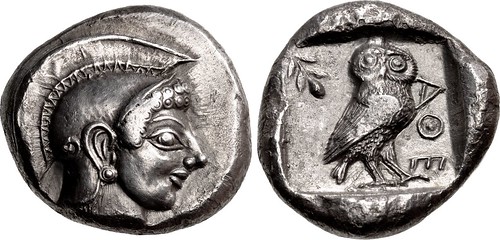
Lot 252–ATTICA, Athens. Circa 510-500/490 BC. AR Tetradrachm (26mm, 16.98 g, 9h). Head of Athena right, wearing crested Attic helmet decorated with small spiral on the bowl, and round earring / Owl standing right, head facing; olive sprig to left, ATE to right; all within incuse square. Seltman Group L (unlisted dies, but same hand as obv. dies A214–5); Svoronos, Monnaies, pl. 8, 8–13; HGC 4, 1589; Dewing –; Rhousopoulos 1945. Lightly toned, a few small cleaning marks on reverse. EF. Estimated at $20,000
From the Jonathan P. Rosen Collection. Ex Gemini XIII (6 April 2017), lot 41.
Ex Sheikh Saud Al-Thani and JDL Collections
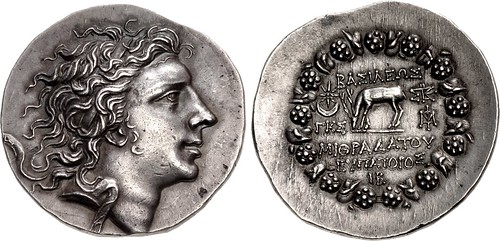
Lot 293–KINGS of PONTOS. Mithradates VI Eupator. Circa 120-63 BC. AR Tetradrachm (35.5mm, 16.62 g, 12h). Pergamon mint. Dated month 12, year 223 BE (September 74 BC). Diademed head right / Stag grazing left; BASI?EOS above, MITPA?ATOY/EY?ATOPOS in two lines below; to left, star-in-crescent above GKS (year); two monograms to right, IB (month) in exergue; all within Dionysiac wreath of ivy and fruit. Callataÿ p. 21, dies D55/R4, a (this coin, illustrated on pl. XI); HGC 7, 340; DCA 692; SNG BM Black Sea 1042; du Chastel 245; Leu 42, lot 269 (same dies). Virtually as struck, with a lovely old cabinet tone. Superb EF. Undoubtedly the finest specimen known. A spectacular portrait struck on an exceptionally broad flan. Estimated at $30,000
From the Jonathan P. Rosen Collection. Ex Classical Numismatic Review XLII.1 (Winter 2017), no. 436344; Sheikh Saud Al-Thani Collection (Numismatica Ars Classica 92, 23 May 2016), lot 185; JDL Collection (Numismatica Ars Classica 74 and Tradart 18 [joint sale], 18 November 2013), lot 289 (hammer 65,000 CHF); The Numismatic Auction II (12 December 1983), lot 122.
Mithradates is the Hellenistic monarch par excellence, his career driven by megalomaniacal ambitions leading to murderous assaults upon family and followers and disastrous foreign adventures against superior forces. His idealized portraiture attempts to mimic the gods with its bold staring gaze and unruly, free-flowing hair, but at its most extreme is a personification of hysteria in its Dionysiac sense. The wreath of ivy on the reverse reinforces Mithradates' link with the god as well as making a connection with the cistaphoric coinage that circulated in the area. The stag probably represents the civic center of Ephesos and the mintmark is of Pergamon, all part of the new Pontic kingdom, symbolized by the star and crescent. His empire collapsed before the armies of Sulla and Lucullus, and Mithradates ended his own life in exile in the far region of the Crimea, pursued to the end by vengeful Romans and family.
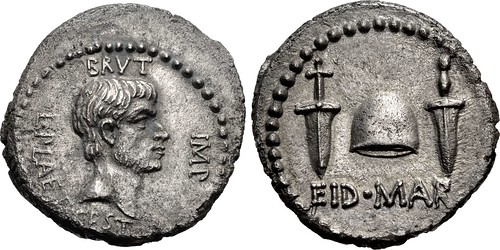
Lot 620–The Republicans. Brutus. Late summer-autumn 42 BC. AR Denarius (18mm, 3.49 g, 12h). Military mint traveling with Brutus and Cassius in western Asia Minor or northern Greece; L. Plaetorius Cestianus, magistrate. Bare head of Brutus right; BRVT above, IMP to right, L • PLAET • CEST around to left / Pileus between two daggers pointing downward; EID • MAR below. Crawford 508/3; Cahn 20 (same dies); CRI 216; Sydenham 1301; RSC 15; BMCRR East 68-70; Kestner –; RBW –. Lightly toned, minor porosity. With NCG Photo Certificate 4936619-007, graded Ch AU, Strike: 5/5, Surface: 3/5. Very rare. The most famous of all Roman coins. Estimated at $200,000
From the Jonathan P. Rosen Collection. Ex Tklaec AG (8 September 2008), lot 188
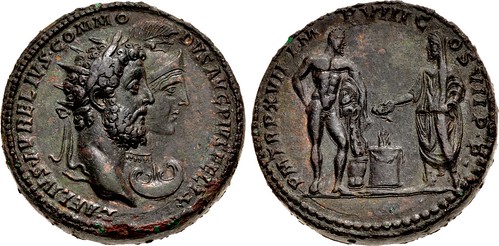
Lot 775–Commodus. AD 177-192. Bimetallic Medallion (40mm, 69.15 g, 12h). Rome mint. Struck AD 191-192. L • AELIVS • AVRELIVS • COMMO DVS AVG PIVS FELIX, jugate heads of Commodus, radiate, and Amazon (Marcia or Roma), wearing crested helmet with visor, necklace, and pelta on chest / P M TR P XVII • IM P VIII C OS VII P • P, on left, Hercules, naked, right hand behind back, holding club draped with lion's skin set on stone; on right, Commodus, wearing sacerdotal dress, standing left, sacrificing with patera in right hand over lighted and garlanded altar and holding volumen in left. Gnecchi II, 116, pl. 85, 9 (same obv. die); Grueber 33, pl. XXXIV; Froehner p. 143; MIR 18, 1158-2/50; Cohen 2; Banti 4 (Commodus and Marcia); cf. Firenze 64. Green-brown patina, lightly chipped around edge. Near EF. Very rare. Estimated at $20,000
This remarkable obverse has been the cause of debate. The pelta, a distinctively Amazonian shield, has long led some to identify the female figure as Marcia, Commodus' concubine and trusted companion whom, we are told, the emperor loved to see dressed as an Amazon (SHA, Com. 12.1). The idea that Marcia – who was involved in the assassination of Commodus – should appear on a medallion of the emperor struck the year of his death has incredible historical and emotional appeal, and prominent 20th century scholars like Harold Mattingly and Jocelyn Toynbee accepted the identification. Others have discounted this fantastic claim, questioning the likelihood of a mistress with no official role or titles making an appearance on medallions.
Dressel has argued that the pelta could be an attribute of Commodus rather than the female figure. "Amazonius" was one of the many titles the crazed emperor bestowed on himself late in his reign (when Commodus renamed the months of the year, March became "Amazonius"). A similar obverse type also from AD 192 has jugate busts of Commodus and a female figure wearing a helmet and cuirass, normally identified as Minerva. It is possible that the current obverse depicts Roma, as there is some evidence that Roma and Minerva were favored deities of the emperor.
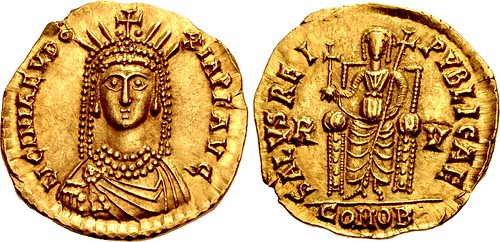
Lot 906–Licinia Eudoxia. Augusta, circa AD 439-490. AV Solidus (20mm, 4.48 g, 5h). Commemorative issue. Ravenna mint. Struck circa AD 439 or 444-445. LICINIA EVDO XIA P F AVG, facing draped bust wearing radiate crown with central cross and elaborate pearl diadem, and pearl necklace of three strands / SALVS REI PVBLICAE, empress enthroned facing, holding globus cruciger in her right hand and long cruciform scepter with her left; R-V//COMOB. RIC X 2023; Depeyrot 16/2; Ranieri 117-8; Biaggi 2356; DOCLR 870. Lightly toned. Superb EF. One of the finest known. Estimated at $100,000
From the Provence Collection. Ex Palombo 17 (20 October 2018), lot 117
Licinia Eudoxia was the only surviving child of the Eastern Roman Emperor Theodosius II, and in 424 AD, at the age of two, was betrothed to her four-year-old cousin, the future Emperor of the Western Roman Empire Valentinian III, in order to reunify the two halves of the Roman world. Their marriage produced two daughters, but was abruptly terminated when Valentinian was killed by two Scythians, Optelas and Thraustelas, at the behest of the usurper Petronius Maximus. After buying off the military and palace officials, Maximus cemented his claim to the throne by forcibly marrying Eudoxia only a few days after her husband's murder. At least one historian theorized that Maximus' marriage to Eudoxia was motivated by revenge against the late Valentinian in return for the Emperor's rape of Maximus' first wife. Maximus also married his son Palladius to Eudoxia and Valentinian's daughter Eudocia, thereby severing her engagement to Huneric, the son of the Vandal king Gaiseric.
Deeply unhappy, Eudoxia somehow managed to contact Gaiseric to beseech him to depose Maximus. The Vandals successfully besieged Rome and carried Eudoxia off to Carthage, along with her daughters; Maximus was assassinated by members of the Imperial household during the siege and his body thrown into the Tiber. In 462 AD, after seven years in Carthage, Eudoxia and her daughter Placidia were ransomed by Leo I and moved to Constantinople, while Eudocia remained in Carthage and married Huneric as her parents had originally intended. The rest of Eudoxia's life passed unrecorded; even her exact date of death is unknown.
Struck at Lucca After the Defeat of Desiderius in 774
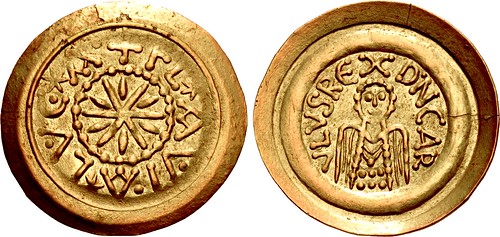
Lot 1025–CAROLINGIANS. Charlemagne (Charles the Great). As Charles I, King of the Franks, 768-814. AV Tremissis (18mm, 1.00 g, 12h). Lucca mint. Struck after the defeat of Desiderius in 774. + FL (star) A VI • A (star) LVC (star) A •, six-rayed star; small leaves between rays; pellet in Vs and C / D • N CAR VLVS R?X, facing half-length bust. Cf. Grierson, Coins of Medieval Europe, p. 31; Rossini 3; Bernareggi –; Bernareggi, Tremissi –; Bernareggi, Moneta, –; Depeyrot 515B = CNI IX 1 = Gariel 172 = Kluge 199; BMC Vandals –; Arslan –; MEC 1, –; E&S p. 213. A coin of great historical and iconographic interest. Areas of light toning, trace of lamination, a couple of hairline flan cracks. EF. Extremely rare. Estimated at $100,000
From the Richard A. Jourdan Collection of Medieval European Coins. Ex CNG Inventory 520231.
The only gold coin to bear a portrait of Charlemagne, one of the most important figures in world history. His deeds shape Europe to this day.
Following Charlemagne's conquest of the Lombardic kingdom in 774 AD, a short-lived issue of gold tremisses was struck at a range of mints across northern Italy in his name. These rare coins are all of the same star/cross potent type of the defeated Desiderius, except for an extremely rare issue at Lucca that remarkably depicts the King of the Franks on the reverse. Rossini records only six specimens of the portrait issue, four of which are damaged and incomplete. Only one other example has previously appeared at auction. That coin, from the Adams collection (Triton XIX, lot 2207), realized $180,000 in 2016.
From the Murdoch and Copp Collections
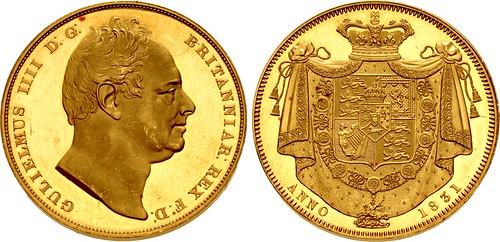
Lot 1346–HANOVER. William IV. 1830-1837. Pattern AV Five Pounds (38mm, 39.87 g, 5h). London mint. Dated 1831. GULLIELMUS IIII D : G : BRITANNIAR : REX F : D :, bare head right / Coat-of-arms within Order of the Garter, crowned and mantled; ANNO 1831 below. L&S 2; ESC 272; Montagu 1086; W&R 270 (this coin cited); SCBC 3833. In NGC encapsulation 4747472-001, graded PF 62 Ultra Cameo. A magnificent coin. Attractively toned with a deep cameo finish. Extremely rare. Estimated at $200,000
From the G.W.K. Roberts Collection. Ex Schweizerischer Bankverein 4 (17 October 1978), lot 260; J. G. Murdoch Collection (Part III, Sotheby, Wilkinson, & Hodge, 15 March 1904), lot 437; A. E. Copp Collection, sold privately in 1887.
Struck to the exact weight of five Sovereigns from the dies used for the proof Crown of 1831, this pattern Five Pounds of William IV is one of the great rarities of the British series. For any collector attempting to form a complete collection of Five Guinea and Five Pound pieces by monarch, from Charles II to Elizabeth II, the Five Pounds of William IV is by far the most challenging coin to obtain.
The specimen offered here is in superb condition and has not been on the market for over 40 years. It once graced the celebrated cabinet of John Gloag Murdoch, one of the finest collections of British coins ever assembled. Murdoch acquired the coin in 1887 from Alfred Evelyn Copp, the Treasurer of the Numismatic Society of London and distinguished collector of rarities.

STEPHEN ALBUM RARE COINS AUCTION 36
Here's the press release for Stephen Album Rare Coins Auction 36. Nice material. -Editor
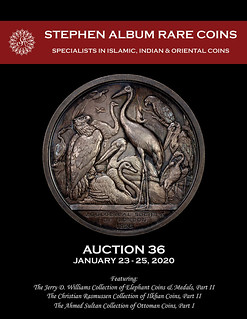 Stephen Album Rare Coins will hold its Auction 36 on January 23-25, 2020 at its offices in Santa Rosa, California. The auction is comprised of exactly 3,100 lots of
Ancient, Islamic, Chinese, General World, and Indian coins, as well as a small selection of Numismatic Literature. Single lots will be available for viewing at the New York
International Numismatic Convention (NYINC) from January 16 to 19.
Stephen Album Rare Coins will hold its Auction 36 on January 23-25, 2020 at its offices in Santa Rosa, California. The auction is comprised of exactly 3,100 lots of
Ancient, Islamic, Chinese, General World, and Indian coins, as well as a small selection of Numismatic Literature. Single lots will be available for viewing at the New York
International Numismatic Convention (NYINC) from January 16 to 19.
Some featured collections in the sale include; The Jerry D. Williams Collection of Elephant Coins & Medals Part II, The Ahmed Sultan Collection of Ottoman Coins, and The Christian Rasmussen Collection of Ilkhan Coins Part II. The firm's founder Stephen Album has commented that, "The Islamic coins offered in this auction are unprecedented in terms of both rarity and scope".
The sale also contains a number of high grade Chinese dollars that are sure to see spirited bidding.
Both internet and floor bidding are available for this sale. Some highlights from the sale follow:
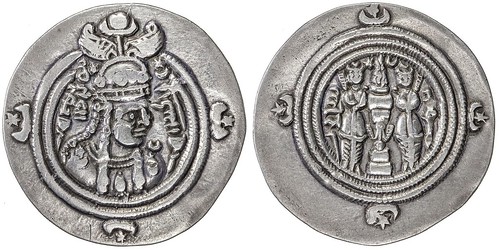
LOT 138 - SASANIAN KINGDOM: Queen Boran, 630-631, silver drachm (3.64g), AM (Amul), year 1, G-228, cf. Saeedi-299, extremely rare mint for Boran, located in northern
Iran near the Caspian Sea, pleasing VF, RRR
Estimated Value $3,250 to $4,000
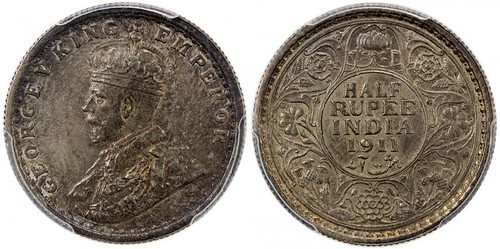
LOT 1362 - BRITISH INDIA: George V, 1910-1936, silver ½ rupee, 1911 (c), KM-521, Prid-318, S&W 8.61, nice natural toning, one-year type, a fine example of this true
rarity! PCGS graded MS64, RR
Estimated Value $7,000 to $9,000
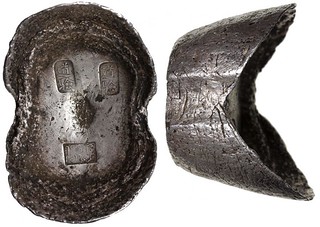 LOT 1453 - CHINA: silver 50 tael (liang) sycee (1737g), Sinkiang Province, Cribb-BMC-Class-XVI, Group A, #111, Xinjiang Yuanbao Chinese Turkestan Principal Ingot,
Local Tax Ingot, stamped twice vertically dao yàn (Circuit Inspector) and once horizontally with Turki inscription "[Silver] Smith Ahmad at the Pasha's Office",
minor surface marks with well applied and clearly defined stamps and attractive old tone, VF, RR. Although similar in style and manufacture to the Hubei Ersibao (Class XIII)
ingots, the Sinkiang ingots are clearly a class of their own. Aside from the use of multiple languages of Chinese and Uighur, they are cast from a smaller mold with narrow sides
which causes them to be smaller and broader at the base.
LOT 1453 - CHINA: silver 50 tael (liang) sycee (1737g), Sinkiang Province, Cribb-BMC-Class-XVI, Group A, #111, Xinjiang Yuanbao Chinese Turkestan Principal Ingot,
Local Tax Ingot, stamped twice vertically dao yàn (Circuit Inspector) and once horizontally with Turki inscription "[Silver] Smith Ahmad at the Pasha's Office",
minor surface marks with well applied and clearly defined stamps and attractive old tone, VF, RR. Although similar in style and manufacture to the Hubei Ersibao (Class XIII)
ingots, the Sinkiang ingots are clearly a class of their own. Aside from the use of multiple languages of Chinese and Uighur, they are cast from a smaller mold with narrow sides
which causes them to be smaller and broader at the base.
Estimated Value $8,000 to $10,000
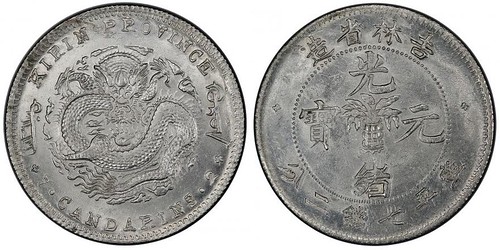
LOT 1509 - KIRIN: Kuang Hsu, 1875-1908, silver dollar, ND (1898), Y-183, L&M-516, large scales on dragon variety, PCGS graded MS62
Estimated Value $10,000 to $15,000
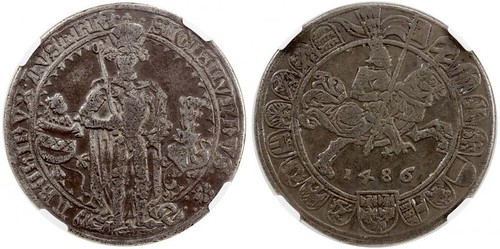
LOT 1720 - TIROL: Sigismund, 1477-1490, silver guldinar, 1486, Dav-8087, Levinson IV-49a, Frey-274, Hall Mint issue, die-cutter Wenzel Kröndl, Archduke standing slightly
right facing with sword and scepter with .SIGISIIUnNDVS:*: - ARChIDVX.AVSTRIE. around // knight on horseback right holding flag with date below and 16 provincial arms around, bold
strike, never mounted and problem-free, NGC graded VF20, RR. This is the oldest dated thaler, preceded in 1484 by the halfguldiner. Archduke Sigismund had already produced gold
florins in large numbers, but the Schwaz silver mine was yielding a huge amount. So the idea for a big silver coin worth a gold guilder arose. However, these coins did not get
their name until the beginning of the 16th century, the "Joachimstalers", later called Talers, which were coined in the Bohemian Joachimstal by the Counts Schlick. With
a 1:12 ratio of gold to silver, a large silver coin of 31.9g (29.9g fine) was produced.
Estimated Value $8,000 to $10,000
The firm is now taking consignments for its Auction 37 on May 28-30, 2020.
More information can be found on their website at www.stevealbum.com

NUMISMATIC NUGGETS: DECEMBER 22, 2019
Here's a selection of interesting or unusual items I came across in the marketplace this week. Tell us what you think of some of these. -Editor
Middlesex Antislavery Token
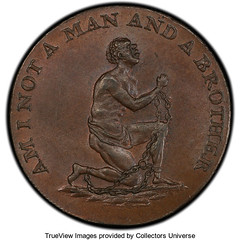
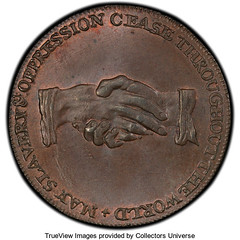
Middlesex copper "Political Series - Antislavery" 1/2 Penny Token ND (1790s) MS65+ Brown PCGS, D&H-1038a. An astonishing and virtually problem-free example of this most popular Conder token series, aged to a rich cocoa with cupric red elements at the legends.
From the Heritage January 2020 sale. -Editor
To read the complete lot description, see:
Great
Britain: Middlesex copper "Political Series - Antislavery" 1/2 Penny Token ND (1790s
(https://coins.ha.com/itm/great-britain/great-britain-middlesex-copper-political-series-antislavery-1-2-penny-token-nd-1790s-ms65-brown-pcgs-/a/3082-34050.s)
Pidcock's Farthing Token
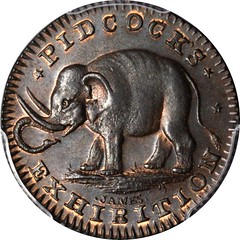
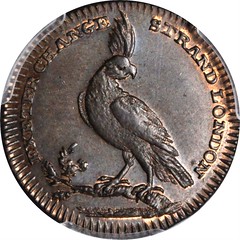
GREAT BRITAIN. Middlesex. Pidcock's Farthing Token, ND (1790s). PCGS MS-65 Brown Gold Shield.
D&H-1067a. Pidcock's Exhibition. Obverse: Elephant, "JAMES" below; Reverse: Crested cockatoo on a branch. Some mint red, boldly struck with lovely surfaces.
Stack's Bowers January 2020 sale; from the Q. David Bowers collection. -Editor
To read the complete lot description, see:
GREAT BRITAIN. Middlesex.
Pidcock's Farthing Token, ND (1790s).
(https://auctions.stacksbowers.com/lots/view/3-L9T6B/great-britain-middlesex-pidcocks-farthing-token-nd-1790s-pcgs-ms-65-brown-gold-shield)
Bergen Iron Works Token
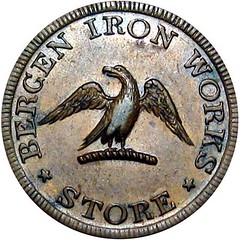
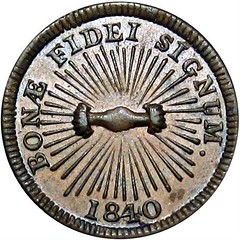
538 - LOW 180 / HT-205A R4 Raw AU+ Bergen Iron Works Store, Lakewood New Jersey. Struck in Copper and much rarer than the Brass variety, particularly this nice. A well struck EF+ brought $351 in our December 2017 auction. From the Robert Williams collection.
Sold by Steve Hayden. -Editor
To read the complete lot description, see:
538 - LOW 180 / HT-205A R4 Raw AU+ Hard Times token
(https://www.civilwartokens.com/Event/LotDetails/2798549/538-LOW-180-HT205A-R4-Raw-AU-Hard-Times-token)
1879 Victoria Specimen Pattern Penny Token
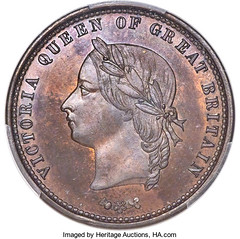
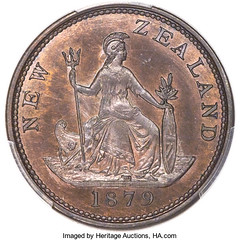
Victoria Specimen Pattern Penny Token 1879 SP64 Brown PCGS, Allen & Moore's mint (in Birmingham), KMX-Pn1, Andrews-399, Lampard-336. By James Moore. The designer, Moore, was a recognized and respected engraver who, among other things, produced a number of Victorian medals. This ultimately unadopted pattern selection displays sharply struck features, alongside an intermingled patina of chestnut and mahogany, laid over glossy surfaces
From the Heritage January 2020 sale. -Editor
To read the complete lot description, see:
New Zealand: Victoria Specimen Pattern Penny
Token 1879 (https://coins.ha.com/itm/new-zealand/new-zealand-victoria-specimen-pattern-penny-token-1879-sp64-brown-pcgs-/a/3081-31083.s)
THE BOOK BAZARRE
WHAT IS ‘TREASURE'? ASK THE CORONER
So why is it that in England a coroner decides what is declared treasure for the purpose of dividing the proceeds of found coin hoards? Max Hensley forwarded this Atlas Obscura article which traces the historical background. Thanks. -Editor
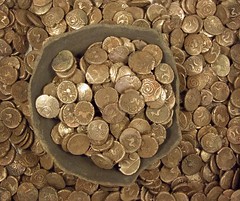 "The modern role is almost entirely focused on the investigation of deaths, but at the time revenue control was part of that," says Matthew Lockwood, a historian at the
University of Alabama and an expert in early British history, who wrote his dissertation on the coroner's role in British life. "The responsibility for investigating treasure and
wreck of the sea goes sort of hand-in-hand with the investigation of death.
"The modern role is almost entirely focused on the investigation of deaths, but at the time revenue control was part of that," says Matthew Lockwood, a historian at the
University of Alabama and an expert in early British history, who wrote his dissertation on the coroner's role in British life. "The responsibility for investigating treasure and
wreck of the sea goes sort of hand-in-hand with the investigation of death.
"Some of the early broader roles are sort of swept away," Lockwood adds, "so we're left with treasure trove and investigating untimely deaths." It is still up to coroners—who weren't particularly associated with having medical knowledge until the 1800s—to distinguish between deaths accidental, natural, and foul, and to distinguish between trinket and treasure.
"It's very obscure," Lockwood says, "but at the same time it's a bizarre holdover from a previous age that doesn't seem like it should exist in the modern age, but it does."
What is treasure and what is not was a significant distinction as far back as the Roman Empire, when treasure was defined, rather specifically, as a horde of money that has been buried so long an owner cannot be identified. It has been a subject of English law as far back as Edward the Confessor, who reigned in the early 11th century. And today, naming something as treasure still carries profound implications.
"Prior to [1996], it was very loose and in order for something to be classed as ‘treasure trove,' a find had to be predominantly gold and silver. Its original owners had to be unknown, but it also had to be buried with the intention of future recovery," says Richardson, who sorts though hundreds of treasure inquiries each year passed to him by local municipalities. "It means that in practice the majority of things classed as ‘treasure trove' were coin hoards, obviously put in the ground by people with the hopes of recovering later and they never did."
To read the complete article, see:
In England, Coroners Decide What Is Treasure and What Is Not
(https://www.atlasobscura.com/articles/coroners-england-treasure-rules)

WAYNE'S NUMISMATIC DIARY: DECEMBER 22, 2019

The evening of Tuesday, December 17, 2019 brought a special event - the annual holiday dinner of my Northern Virginia numismatic social group, Nummis Nova. Dave Schenkman was our host, and he'd arranged for a room at Gadsby's Tavern in Alexandria, VA. John Gadsby operated the hotel and tavern from 1796 to 1808. His establishment was a center of political, business, and social life in early Alexandria. The tavern was the setting for dancing, theatrical and musical performances, and meetings of local organizations. George Washington twice attended the annual Birthnight Ball held there in his honor. Other prominent patrons included John Adams, Thomas Jefferson, James Madison, and the Marquis de Lafayette.
I'd left work early to go home and pick up my wife Dee. We fought D.C. rush hour traffic and the dark rainy night to arrive shortly after 6:30pm. Most of our regular members and their spouses were already there, including: (at the back table) Gene and Amelia Brandenburg, Tom Kays, Eric Schena, and Dave and Joanne Schenkman; (at the center table) Steve Bishop, Joe and Hope Esposito, Robert Hoppensteadt and his wife Laura Gerhard, and Jon Radel; (at the front table) Wayne Herndon.
Dee and I sat across from Wayne. His wife Karin was sick and unable to attend. We were soon joined by Julian Leidman and Joe and Alice Levine.
The room was candlelit and our servers were wearing late 1700s garb. Tom Kays distributed chocolate coins, and Gene Brandenburg presented custom Christmas tree ornaments to mark the occasion. Thanks! But there were more surprises in store. Partway through the evening a group of strangers in Santa hats squeezed into the room. it was the Alexandria Men's Chorus promoting their upcoming concert. They sang three wonderful Christmas carols for us.
And present at intervals throughout the evening was the restaurant's resident Colonial Man, who stayed in character while teasing everyone, flirting with the ladies, telling jokes and even performing a couple songs. I think the biggest laugh came from his reference to plans for building a wall along the Potomac River to keep out immigrants from Maryland.
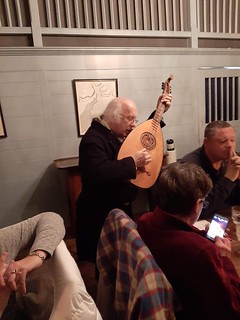
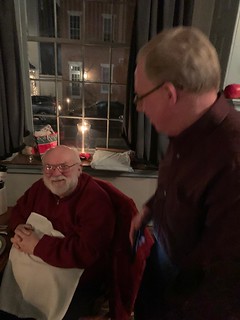
LEFT: Colonial Man playing. Photo by Wayne Homren
RIGHT: Gene Brandenburg and Wayne Homren. Photo by Tom Kays
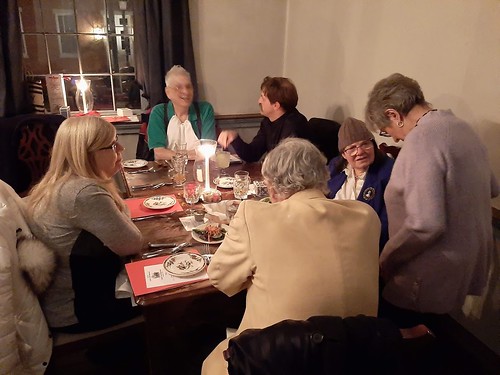
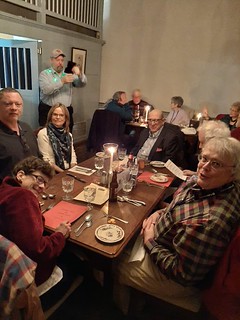
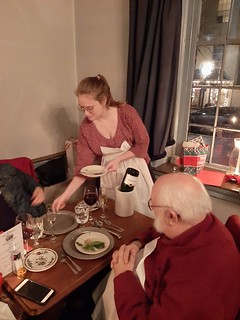
RIGHT: Our colonial server with Gene Brandenburg (seated)
Photos by Wayne Homren
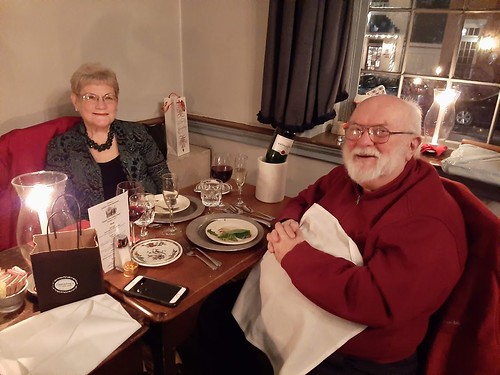
Gene and Amelia Brandenburg. Photo by Wayne Homren
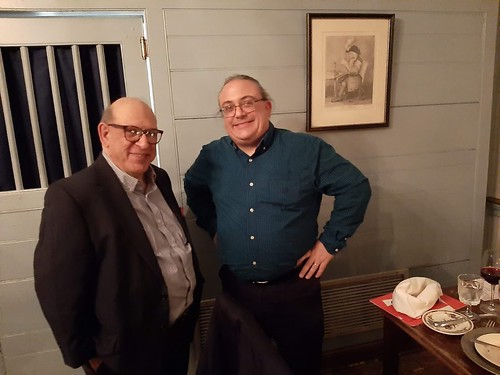
Joe Esposito Eric Schena. Photo by Wayne Homren
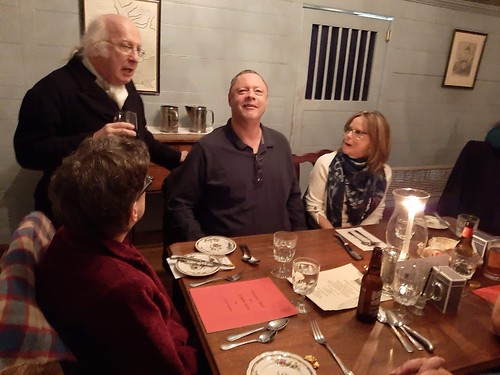
Colonial man at center table. Photo by Wayne Homren
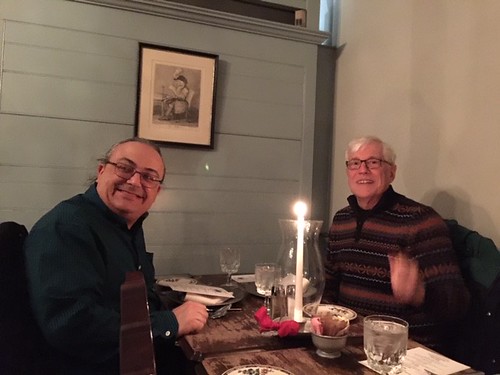
Eric Schena and Dave Schenkman. Photo by Gene Brandenburg
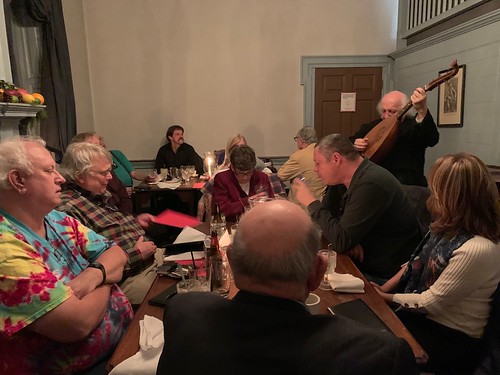
Colonial Man playing. Photo by Tom Kays
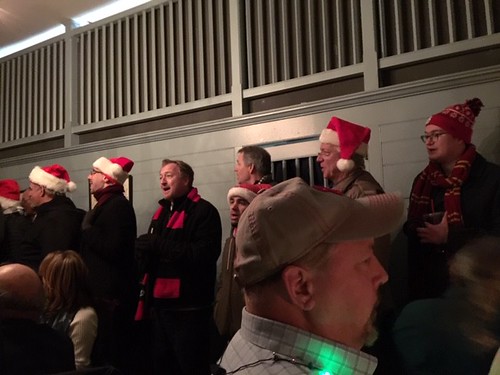
Alexandria Men's Chorus. Tom Kays in foreground. Photo by Gene Brandenburg
It was a delightful and special evening. Many thanks to Dave Schenkman and the staff at Gadsby's.
Holiday Theft at Nummis Nova
Probably the most delightful surprise of the night was when Joe Esposito distributed to everyone a copy of a booklet he'd written and printed for the event. The inside jokes
should be at least somewhat familiar to regular readers of my diary. Thanks, Joe! It's a delight, and with permission I'm republishing it here.
AT
NUMMIS NOVA
By
Ferran Z. Fezziwig
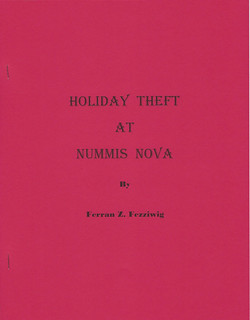 I had run into Wayne Homren a few times at coin shows. I had known him only slightly but enjoyed our conversations. I also read his weekly quotidian wrap-up of all
things numismatic in the E-Sylum online newsletter. I learned something about him reading his periodic updates—monthly, I believe—about some mysterious dinner gathering of
numismatists known as Nummis Nova. I learned, for example, that he frequently had to battle traffic to get to the meals and that he usually spotted Eric Schena or David Schenkman
after parking his car.
I had run into Wayne Homren a few times at coin shows. I had known him only slightly but enjoyed our conversations. I also read his weekly quotidian wrap-up of all
things numismatic in the E-Sylum online newsletter. I learned something about him reading his periodic updates—monthly, I believe—about some mysterious dinner gathering of
numismatists known as Nummis Nova. I learned, for example, that he frequently had to battle traffic to get to the meals and that he usually spotted Eric Schena or David Schenkman
after parking his car.
But I was somewhat surprised when he called and invited me to be a guest at the group's holiday dinner in Alexandria. I was all in, especially as I thought he was paying for the meal. Still, when I learned that was not the case, I agreed anyway. The dinner was being held at Gadsby's Tavern, a quaint and historic old restaurant right there in Old Town.
My wife would not be accompanying me. She ditched me years ago over my coin addiction; she seemed to tolerate the thousands that I paid for gold coins—although I only told her about half of them—but became incensed to learn that I went overboard on a Virginia token. "Five thousand for a tiny coin from a defunct funeral parlor in Roanoke? Are you crazy?" Actually, it was rather practical: a "good for" a speedy burial ("Quickest Casket in Town"). I was guided by Schenkman's book, but that meant nothing to her. She is now collecting Faroe Island stamps at her new house in San Diego.
Well, I pulled into the garage (spot 2A), next to a 1995 Cadillac and a new model Porsche. I turned off the ignition and thought about what the night would bring. It would be more about crime than coins.
I soon met a few of the numismatists. I knew them because they were slightly older than the other clientele at the tavern. Some carrying pouches, apparently holding on—with great security—to the treasures that they were bringing to pass around.
That's a tradition at these dinners, I'm told, but less so at the annual holiday event. However, some may have forgotten it was a special dinner and others carry their coins around all the time (when not in the vault) so they were on autopilot. Some had wives with them, but I fear that I will not remember their names.
I was seated next to Homren and someone named Esposito, who I was told had recently written some second-rate book about a Nummis Nova dinner or something like that. Esposito seemed to immediately take umbrage when I told him he looked like Yogi Berra. No matter, I was there to have a good time.
The room was dark and the people who started to pass around their collections were frustrated by the poor light. The wives ignored the shop talk; they hear it all the time. Schenkman, the king of tokens, commented on his very rare—perhaps unique—time traveler token from the 1920s. He said that the cell phone on the obverse and the image of a drone on the reverse was inconsistent with the twenties—but the date stamped on it was 1927! He is going to do an article about it for The Numismatist.
Tom Kays proceeded to circulate a massive tray of colonial coins. I liked them, but some included a foreign language; I now only collect what I can read. I once bought a colonial coin that said "Facsimile" and I didn't learn until later that it was not describing a historical event.
An even bigger exhibit was Steve Bishop's slabbed tie-dyed shirt. It is amazing how slabbing has expanded in scope and size. This beauty is VF 35 and nicely toned—an early die variety. All I can say is that it was both far out and groovy.
I spoke briefly to Wayne Herndon, who was seated across from me at a long table. Someone said he was a wizard or that he owned a wizard store and he had a warehouse full of that stuff. I guess that's a branch of numismatics that I've not encountered before. He seemed quite knowledgeable about what he was discussing but I kept looking for a wand.
The food was now being delivered along with the apparition of James Madison. He was better than Elvis, of course, but the guy kept talking about horses and General Washington. When Jemmie mentioned his wife, Dolley, the ears of several of the collectors perked up: They were already contemplating ice crème (this is a crowd noted for their appetite). Throughout his cameo appearance, I was struck by how short Madison was—almost as short as Esposito—and that caused me to wonder whether he bought his clothes in the kid's department. He also needed a haircut.
Now just as the colonial-style appetizers were being served, I saw that Julian Leidman, a legendary coin dealer, was presented with a massive bowl of whipped crème. I was told that Julian likes whipped crème. Also, that he was thinking of using whipped crème as a security device in his store in Silver Spring. I didn't know what that meant, but I sure was envious about his dish.
As I mentioned, this is an older crowd. This was reinforced when one of them—I probably shouldn't tell—spoke longingly about Lawrence Welk and his Champagne music makers. Somebody mentioned that Topo Gigio from the Ed Sullivan Show was his hero. Another, incredibly, talked about once babysitting a young Eric Newman. One guy began collecting coins during the Spanish- American War. But, boy did they have the numismatic experience.
One award was given out: Eric Schena was honored for travelling 500,000 miles to and from Nummis Nova dinners over seven years. The award was an obscure—nigh, unique—store scrip from an apothecary in southwestern Virginia. Most gave him a standing ovation while a few continued eating.
But the highlight of the evening was the circulation of an 1895 Morgan silver dollar in proof. Wow! It was worth multiples more than my car, which was in spot 2A. But that's when a peculiar thing happened. Everyone was oohing and aahing about the coin, but it never made it around to me. Somewhere between Robert Hoppensteadt and Steve Bishop—they were a long half-table apart—the coin disappeared. Well, when that was discovered, there was considerable mayhem.
Wayne Homren mentioned that a valuable coin had once been lost at a Sphinx Club dinner but that it was simply mistaken for pocket change. Hoppensteadt, who writes novels, said that maybe something untoward had occurred. I take whatever a writer says with a few grains of salt, but still it was missing. Almost immediately, everyone stood up, checked their seats and most of them started looking around the old hardwood floor for the pricey treasure.
Steve Bishop and Jon Radel offered to frisk other diners, but Homren said that we might want to keep it quiet for now. One of them asked the server whether any of the other guests were known criminals. She was puzzled by the question. Still, someone volunteered that a person in the other room looked a lot like Jacob Marley.
We searched and searched but to no avail. Finally, a call was placed to Gene Brandenburg, a mainstay of Nummis Nova but lately unavailable for the dinners after he became a wine consultant for a major grower in Napa Valley. Gene, who I know slightly, said that we should ask everyone to take off their shoes. I did notice that some seemed to be wearing odd footwear, but who would put this coin in their shoe?
The one thing that some hadn't known was whose coin was missing. It was being circulated, but who owned it? It was another guest at the dinner whose name that I didn't get until later; it was Bill. And it was a poor way to treat a guest. Bill was apoplectic.
Some of the diners continued to eat while others were horrified. Everyone checked their envelopes to make sure that a further heist hadn't taking place. One person said it might be a broader conspiracy aimed at numismatists and that the republic might be in peril. Several immediately clutched their coins. Joe Levine, an exonumia stalwart who knows a few things about presidential lore, pronounced the heist in the tradition of the Teapot Dome scandal.
When the principal server returned, we explained what happened. She was a helpful woman, also in colonial garb, and seemed to be genuinely shocked. Schenkman has called servers in the past Transylvanians, but this one was a Virginian. She said such a crime had never happened at the tavern—at least not since the Civil War--and that she would immediately speak to the manager.
Well, it was an odd evening, but I will skip ahead and tell you that the culprit was caught. A scrawny man in his thirties who had slipped into the dark room and pretended to be a server was unmasked as a fraud and the perpetrator of a sleight of hand. What gave him away to the eagle eye of Schena was that he was not wearing period britches. "I'll bet a kopek that something is amiss," he said.
It was hectic that night, and everyone—diners and staff—assumed that he was extra help. It turned out that he was from a rival numismatic group, Nummis Columbia, which was looking to embarrass their largely Virginia brethren—and, get this, bankroll a clubhouse in D.C. Soon the police were on the scene and he was on his way to the slammer and the coin was back in Bill's hands. Fist bumps reigned.
It was an eventful evening as I walked briskly the 213 steps to the parking garage and began the trek home to upper Connecticut Avenue. I was able to get away unscathed; they never knew that I was a behind-the-scenes part of the botched job. But I guess that I'm unlikely to become a member of Nummis Nova.

NEW ZEALAND STERLING COINAGE OFFERED
In his Stack's Bowers blog December 18, 2019, Senior Numismatist and Cataloger Jeremy Bostwick discusses the New Zealand sterling coinage from the Fenton Collection. -Editor
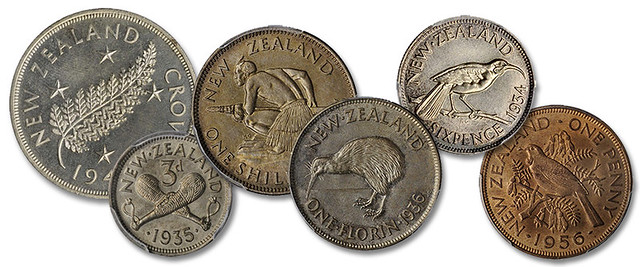
The British Commonwealth has spawned a seemingly endless array of coinages featuring the contemporary reigning monarch along with more indigenous iconography, allowing for a series of issues across the commonwealth of nations that feel similar yet is each different in its own way.
Though the island country of New Zealand may be some 11,000 miles from England, the coinage of the two—beginning with the former's first official issues in 1933—certainly has a similar feel. First up are the iconic numismatic representations of Kings George V and VI, familiar to any collector, followed thereafter by the continually changing renditions of the current sovereign, Queen Elizabeth II. Similar, too, are the denominations themselves and overall coinage system. There, however, the close ties end, with the reverses allowing for a more distinct, local flair and feel. Whether they be representations of the hei-tiki (1/2 pennies), crossed patus (3 pences), and a Maori warrior (shillings), or those of a kiwi (florins), the extinct huia (6 pences), and the tui (pennies), indigenous aspects of the Maori and endemic avian iconography present an appearance that most distinctly signifies New Zealand.
Our upcoming Official Auction of the 2020 N.Y.I.N.C. will present the Fenton Collection of New Zealand Sterling Coinage, a stunning set that has been finely cultivated and curated for the best possible representations of the dates across the circulation strikings. This tremendous collection offers a vibrant and robust date run of 1/2 crowns all the way down to 1/2 pennies, ranging from the period late in the reign of George V, continuing with the reign of George VI, and ending with the young head issues from early in the reign of Elizabeth II. While dates both common and rare are represented, the exceptional quality remains unchanged throughout, as most of the pieces are tied for the finest known—with some even standing alone as the singular finest examples listed in the PCGS census.
To read the complete article, see:
Elite New Zealand Sterling Coinage from the Fenton Collection
(https://www.stacksbowers.com/News/Pages/Blogs.aspx?ArticleID=new-zealand-sterling-coins)
Here are closer looks at some of the coins. -Editor
1936 Three Pence
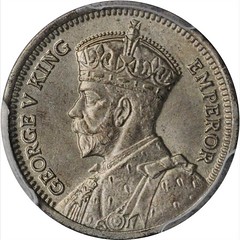
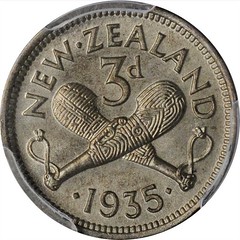
To read the complete lot description, see:
NEW ZEALAND. 3 Pence, 1935. PCGS MS-66 Gold Shield.
(https://auctions.stacksbowers.com/lots/view/3-LA9YQ/new-zealand-3-pence-1935-pcgs-ms-66-gold-shield)
1940 Florin
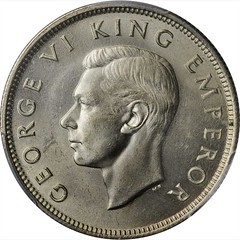
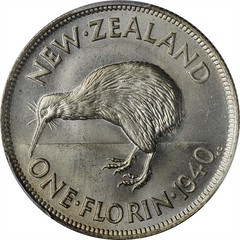
To read the complete lot description, see:
NEW ZEALAND. Florin, 1940. PCGS MS-65 Gold Shield
(https://auctions.stacksbowers.com/lots/view/3-LA9XC/new-zealand-florin-1940-pcgs-ms-65-gold-shield)
1935 Waitangi Crown
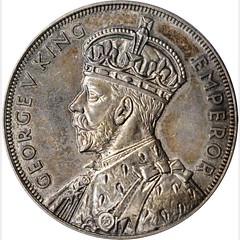
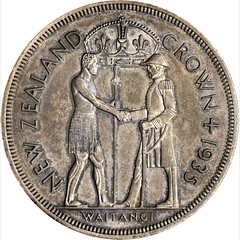
KM-6; Dav-433. Mintage: 468. An incredibly RARE one year type coin, this majestic issue commemorates the king's jubilee as well as the Treaty of the Waitangi in 1840--a treaty which was signed between representatives of the British crown and local Maori chiefs. Always a desirable and classic crown.
To read the complete lot description, see:
NEW ZEALAND. Crown, 1935. London Mint. PCGS PROOF-63
Gold Shield. (https://auctions.stacksbowers.com/lots/view/3-LAB40/new-zealand-crown-1935-london-mint-pcgs-proof-63-gold-shield)
CONGRESS WON'T SPEND MONEY ON MONEY
This article highlights some of the items specifically called out in the new U.S. budget for monies NOT to be spent, and two of them relate to numismatics. -Editor
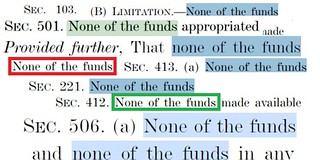 Nearly three months behind schedule, the $1.4 trillion in funding packages approved by Congress for the federal government this past week contained an array of spending
restrictions for money spent by the Executive Branch, covering everything from a ban on buying supercomputers outside the U.S. to leaving hurricane hunter airplanes at a specific
military base in Mississippi.
Nearly three months behind schedule, the $1.4 trillion in funding packages approved by Congress for the federal government this past week contained an array of spending
restrictions for money spent by the Executive Branch, covering everything from a ban on buying supercomputers outside the U.S. to leaving hurricane hunter airplanes at a specific
military base in Mississippi.
Inside the bill were hundreds of provisions which spell out what can not be done with money appropriated by the Congress - known as, "None of the funds."
+ Keep your hands off the $1 bill. This provision has been a part of the Congressional funding bills for a number of years. Why? The vending industry is supposedly the quiet actor here, because they don't want to have to worry about re-configuring vending machines in order to accept a redesigned $1 bill.
+ Don't build any new money museums. Just after the $1 bill provision is one spending restriction that catches your eye, saying no money 'may be used by the United States Mint to construct or operate any museum' without the approval of various committees in the Congress. It would seem that no museum could be built by a federal agency without the approval of Congress, but what do I know.
I've heard bits and pieces of the story behind the museum non-provision. Has it been written up in the numismatic press? Who ticked off who in Congress? -Editor
To read the complete article, see:
Year-end budget measures filled with spending restrictions
(https://www.wpxi.com/news/politics/jamie-dupree/year-end-budget/7RYTMYFQ2HLYFQ2PGOFB4GSQWY/)
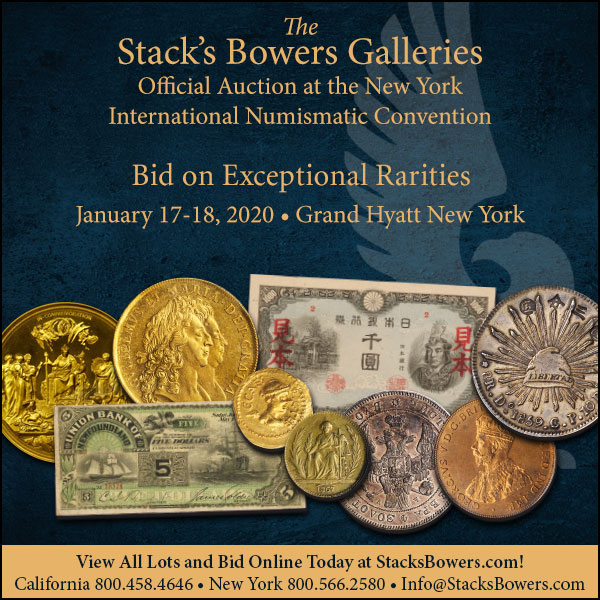
LOOSE CHANGE: DECEMBER 22, 2019
Here are some additional items in the media this week that may be of interest. -Editor
Holabird December 2019 Sales Results
An Alaska gold nugget led this month's Holabird sales, which contained a wide array of numismatic and non-numismatic items. -Editor
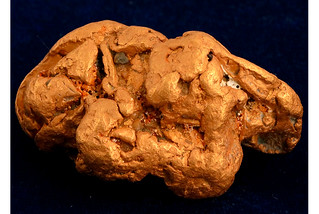 A beautiful 4.51 troy ounce Alaska Gold Rush gold nugget from the Atlin mining district, located just east of Skagway in Yukon, Alaska climbed to $10,845, and an oil on
board painting of two miners on mules loaded with various items, titled Panhandlers, signed by Texas artist William Forrest Martin, nicely framed, realized $8,540 at Holabird
Western Americana Collections' massive, five day Holiday Treasures Auction held December 5th through the 9th.
A beautiful 4.51 troy ounce Alaska Gold Rush gold nugget from the Atlin mining district, located just east of Skagway in Yukon, Alaska climbed to $10,845, and an oil on
board painting of two miners on mules loaded with various items, titled Panhandlers, signed by Texas artist William Forrest Martin, nicely framed, realized $8,540 at Holabird
Western Americana Collections' massive, five day Holiday Treasures Auction held December 5th through the 9th.
To read the complete article, see:
Alaska Gold Rush nugget brings top dollar
at Holabird's Holiday Treasures auction
(https://artdaily.cc/news/119417/Alaska-Gold-Rush-nugget-brings-top-dollar-at-Holabird-s-Holiday-Treasures-auction#.Xf9orWRKhPY)
To read the earlier E-Sylum article, see:
SELECTIONS FROM HOLABIRD DECEMBER 2019 SALES (https://www.coinbooks.org/v22/esylum_v22n48a18.html)
Chinese Trade Dollar from the Sindia Wreck
The Press of Atlantic City posted photos of one of the Chinese dollars recovered from the wreck of the Sindia (see last week's article for more information). -Editor
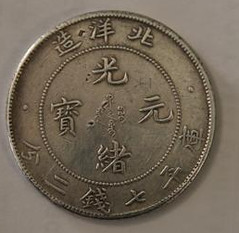
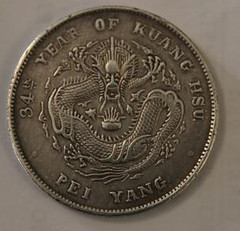
A silver chinese trade dollar, similar to a Morgan silver dollar. Four or five buckets of which were recovered in a 1980's salvage operation. A theory holds these were the true Sindia cargo and the reason for her intentional grounding.
To read the complete article, see:
Photos from
the Sindia presentation at Life Saving Station 30
(https://www.pressofatlanticcity.com/pac/seen-at-sindia-presentation-at-life-saving-station-in-ocean/collection_fefc551f-70bd-5b8f-9b9a-1bc4c096e138.html#3)
To read the earlier E-Sylum article, see:
LOOSE CHANGE: DECEMBER 15, 2019 : Chinese Coin from the Ocean City, NJ Wreck of the Sindia
(https://www.coinbooks.org/v22/esylum_v22n50a23.html)
OXFORD NUMISMATIC SOCIETY CHRISTMAS 2019
David Pickup forwarded this nice Christmas greeting from the Oxford Numismatic Society. Thanks, and Merry Christmas, one and all. -Editor
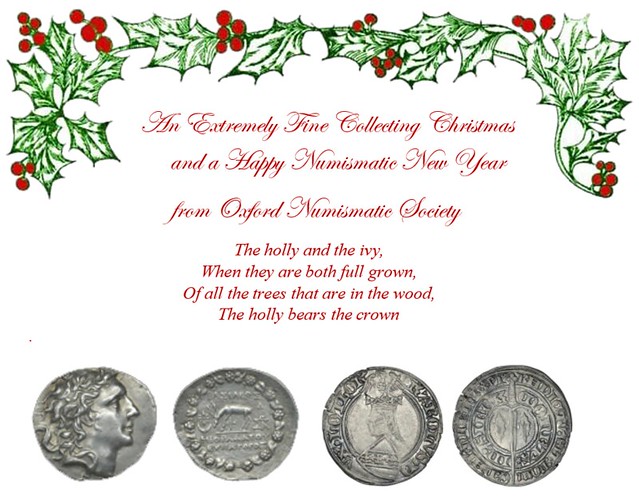
KINGS OF THE PONTOS, Mithradates VI, Tetradrachm, Pergamum, 85/4, diademed head right, rev. stag grazing left, star and crescent to left, monogram and ? to right, all within ivy- wreath. Mithradates VI (135–63 BC) was king of Pontus and Armenia Minor in northern Anatolia from about 120–63 BC. Mithridates is remembered as one of the Roman Republic's most formidable and successful enemies, who engaged three of the prominent generals from the late Roman Republic in the Mithridatic Wars: Lot 794 Date of Auction: 13th March 2018 Sold for £1,800
LORRAINE, Charles II, Gros, minted at Sierck, helmet over shield, rev. sword between holly leaves. Lot 1244 Date of Auction: 21st March 2013 Sold for £270 Charles II (11 September 1365 – 25 January 1431), called the Bold (French: le Hardi) was the Duke of Lorraine from 1390 to his death and Constable of France from 1418 to 1425.
In heraldry, holly is used to symbolize truth. Holly, especially the variety found in Europe, is commonly referenced at Christmastime, and is often referred to by the name Christ's thorn. Since medieval times the plant has carried a Christian symbolism, as expressed in this popular Christmas carol "The Holly and the Ivy", in which the holly represents Jesus and the ivy represents His mother, the Virgin Mary .In Greek mythology ivy was sacred to Osiris and also associated with Dionysus. In Roman mythology Ivy was connected to Bacchus, the god of wine as it grew over his home land. Bacchus is often portrayed wearing an ivy crown, perhaps because this was once thought to prevent intoxication. (It does not)
Images and text used by kind permission of Dix Noonan Webb Ltd
https://www.dnw.co.uk/

